#The Basics on Magic & Classification
Explore tagged Tumblr posts
Text
Page 1: The Basics of Magic & Classification

Will be posting part 2 tomorrow and when all of them are done I will post them all together
Bonus: 2 concepts for the sun and moon symbols
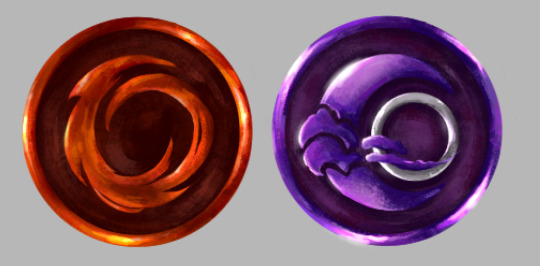
#fantasy worldbuilding#fantasy#writing#art#artists on tumblr#worldbuilding#digital art#character concept#fantasy art#writers on tumblr#Cassie#Cassies sketchbook#The Basics on Magic & Classification#should i post a only text version? it would be a super long post though#also opinions om the symbols?
16 notes
·
View notes
Text
i've gotten asks a few times on like 'how to do ''fantasy races'' without. like. just making race science true in the world'. and i think there's three approaches. the first is harkening back to tolkein and making it clear through framing device or format/tonal cues that you are writing in a mythic register--that you are writing about a world where the basic premises of positivism and empiricism simply aren't true. a world where 'biology' is like, not necessarily a salient premise--where there are things that just cannot be understood. (that's not to say that tolkein's orcs werent v. racialised in v. nasty ways--but it wasn't race science in the way a lot of more modern fantasy is.)
the second way i think is to go and actually understand the history of 'race' as a concept. 'race' has not always existed--it was an ideological invention birthed from / alongisde the enlightmenent and imposed onto populations through military force. in real life, it's less helpful to conceive of 'race' as an attribute someone has and and more as a relationship they have to society. so if you want to actually include scientific racism in your story as an element of your worldbuilding and not something decalred epistemologically true you should be thinking about why these people have been racialized and under what hegemonic paradigm--who, in-universe, invented & enforces the racial classification system that distinguishes between 'human' and 'orc' as taxonomic characters?
the third and final way is to simply think of the traits you understand as belonging to ''fantasy races'' (say, pointy ears and exceptional nimbleness and hundred-year lifespans for elves) as instead just being... more variations in the way people can be. like, in the real world, we do not consider 'tall people' or 'blonde people' or 'myopic people' a different species. in a world where sometimes people have wings or pointed ears or green skin, why should that be different? you've just introduced new types of variation within the population of people--you've just expanded the meaning of human. and of course, right, you can still roughly group these features, or note that some of them are more frequent in some ethnic groups--in much the same way as saying 'on average, people in sweden are taller, paler, and more likely to be blonde and blue-eyed', you can say 'people in these forests tend to be shorter and live longer and have pointed ears'--without having a hard taxonomy that classifies all these attributes as metaphysically different Types Of Person
obviously these are all very different approaches--and there are probably other ways to handle this too! i just get this question a lot whenever i do Orc Discourse and finally felt like getting these thoughts out. there are so so so many places we can take fantasy--let's move the horizon beyond 'magical race science' and imagine genuinely new worlds
4K notes
·
View notes
Text
First Draft on Major Magic Types and Magic Sub-classes
Within the world of Seasonal Decay there are five Major Magic Types, every character within the world has one or more type depending on race.
These classes and their sub-classifications are as follows:

Divine Magic with its sub-classes being in order Contract, Detection, Divination, Healing and Warding.

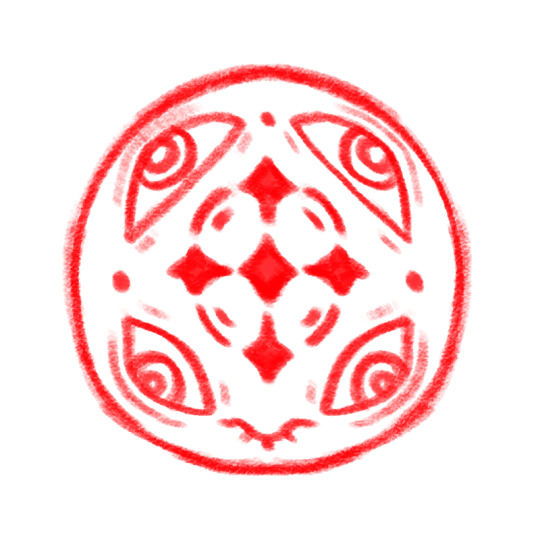



People who have Divine Magic can harness one of the sub-classes. Whether it is predicting and/or manipulating future outcomes, restoring vitality or guarding people and objects from corruption, Divine Magic is the most highly respected Magic type in the world of Seasonal Decay. However, it is in only 12% of bloodlines.
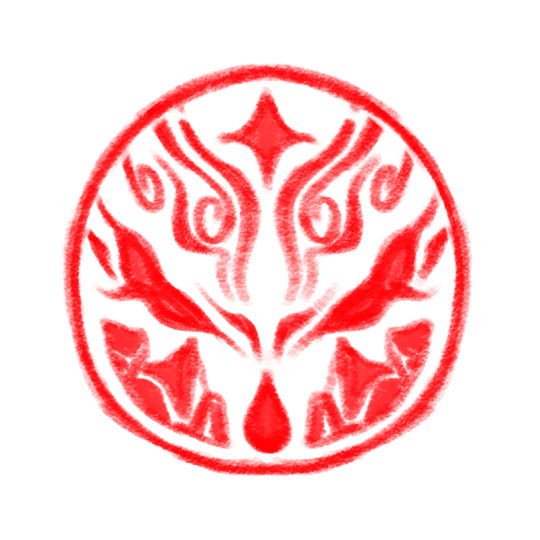
Elemental Magic with its sub-classes in order are Alchemy, Destruction, Elements, Luck and Survival.

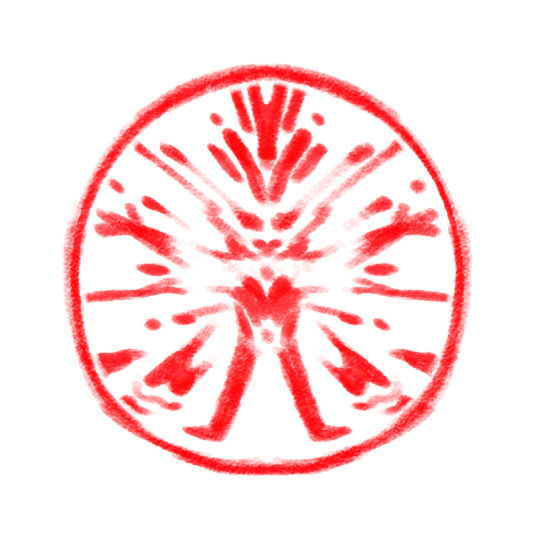
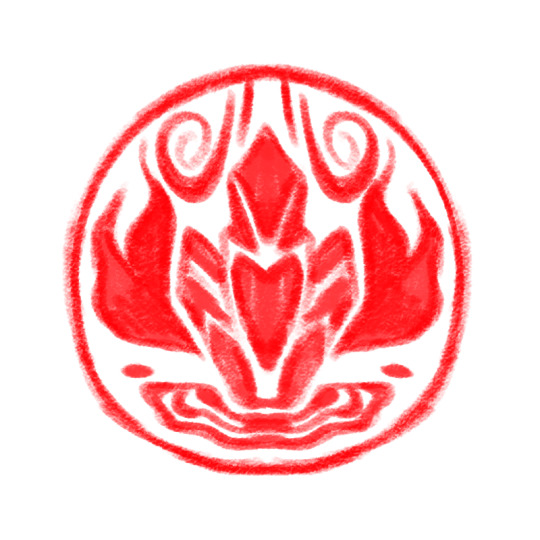


Elemental Magic encompasses magic pertaining to the aspects of the natural world. Such as the basics like Fire, Earth, Water and Air, to far more complex aspects such as manipulation of chance, fortune and survivability. This magic type is the most common with a 54% chance.
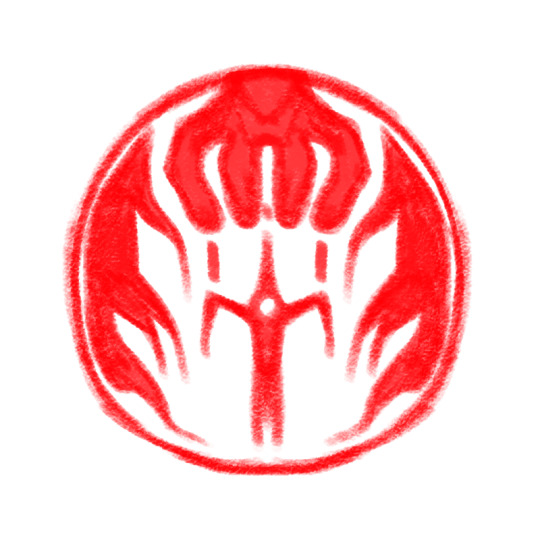
Infernal Magic and its sub-classes in order are Banishment, Concealment, Curse and Necro.
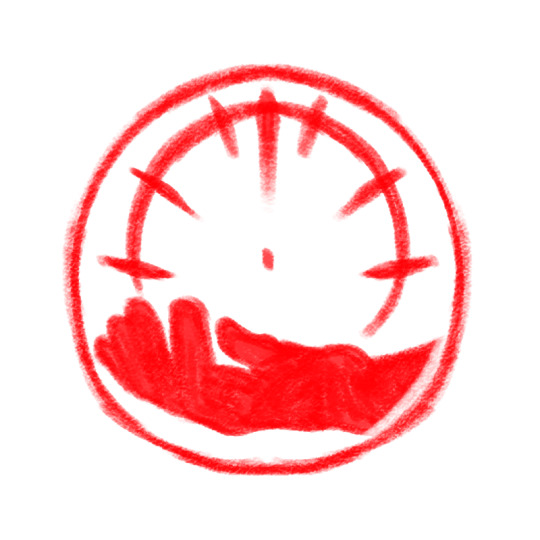

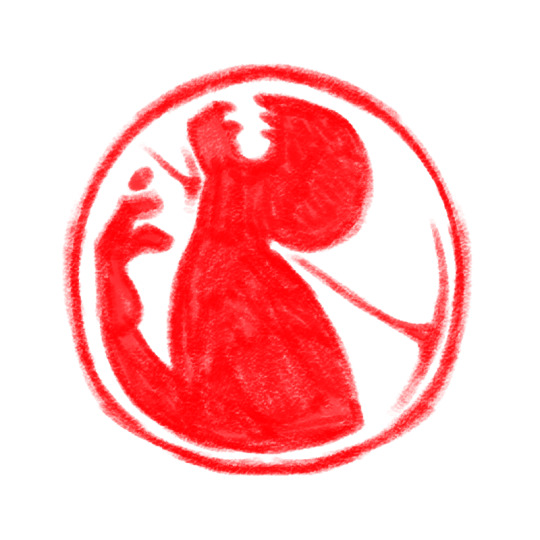

This is the rarest Magic Type with only an 8% chance of showing up in a bloodline. That and its less then pleasant nature give users of Infernal Magic a bad reputation. Not much is known about all uses of this magic, or if they are well known they are not shared outside of those who hold this Magic Type.
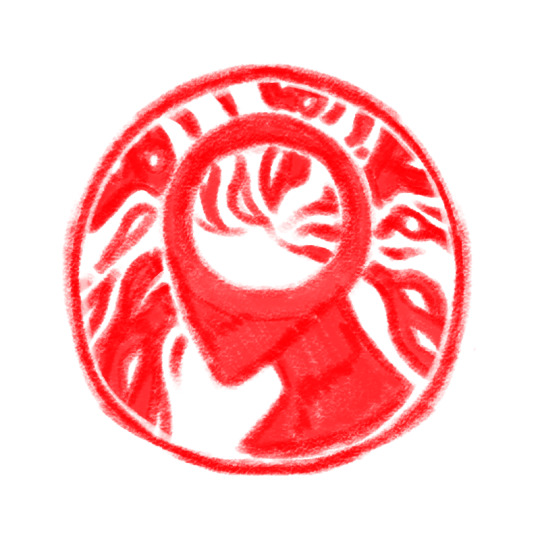
Mental Magic and its sub-classes in order are Communication, Control, Dream, and Illusion.


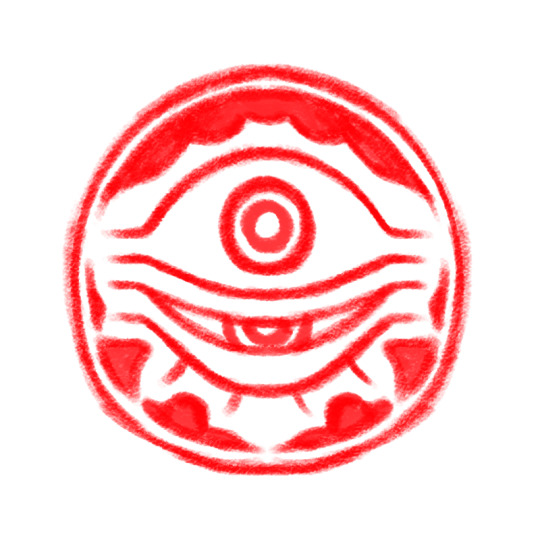
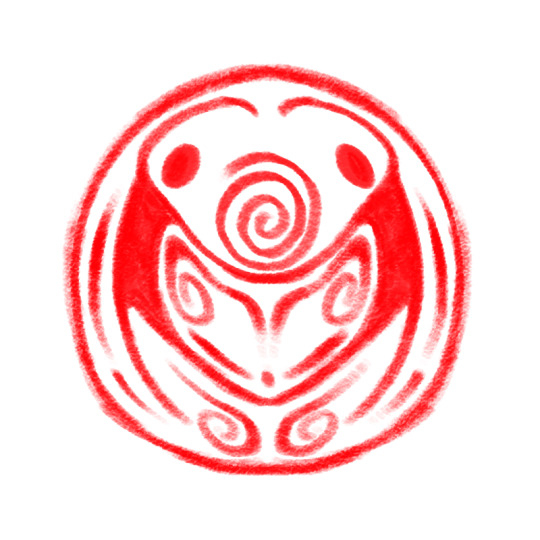
People with Mental Magic range from being able to relay messages through vast distances, walk through the minds of others in sleep, create imagery that isn't there and control the thoughts of others. Though some have suggested that Control Magic could branch off into it's own sub-sections, but further research is needed. This type only has a 10% chance of appearing.
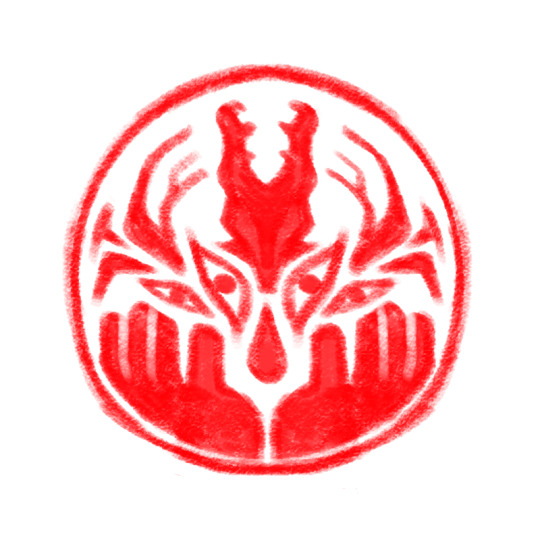
Lastly is Physical Magic and it's sub-classes which are Altercation, Defense, Enhancement, Sensory and Transformation.
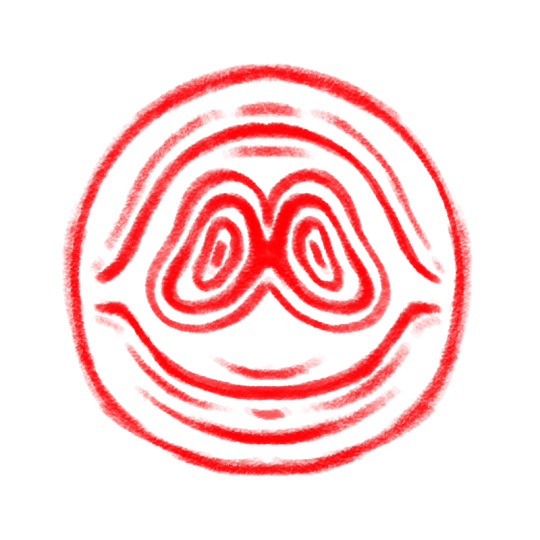
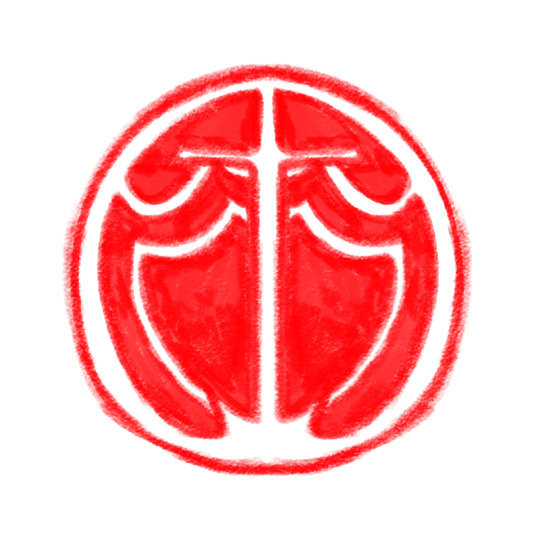
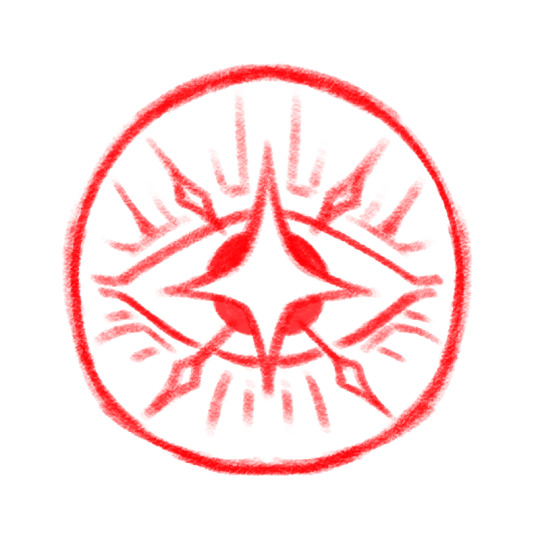

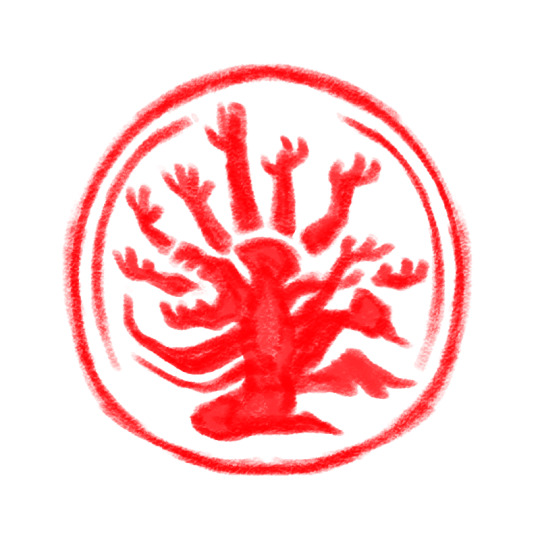
The second most common magic type with 16%, Physical Magic pertains to the ability to create shields and barriers, temporarily disguises, permanent changes of the flesh and heightening senses and attributes.
#digital art#my art#art#seasonal decay#fantasy world#fantasy#fantasy world idea#world building#magic system#original content#original art#concept
120 notes
·
View notes
Note
going off your arcane bolt post and how it becomes spirit bolt in 2, what do you think is the distinction between the arcane and spirit schools? it's interesting that spells which were spirit in dao were moved to arcane to fill it out for da2 (mind blast, crushing prison) and the sort of overlap where both include various shielding methods 🤔
OUGH good question
so for reference for those less familiar, the arcane tree in dao is the very basic single tree with arcane bolt and arcane shield, and spirit is an entire school with two anti-magic trees, the walking bomb/necromancy tree, and the excellent and delightful telekinetic tree. in da2, arcane is a full tree featuring arcane shield, but also elemental weapons which it stole from the elemental/primal schools, and the telekinesis tree (mind blast, barrier, and crushing prison) which it’s stealing from spirit. the spirit tree has spirit bolt (the stolen version of arcane bolt), and then the spells it’s always had like dispel magic, death syphon, and walking bomb.
when you read the codex entries about the schools of magic in origins there are very distinctly four schools: primal, creation, spirit, entropy. the first thing i’d like to establish about my understanding is that these are artificially created distinctions and are not “real”, in the sense that mages trying to understand magic have created classifications to argue about as people love to do. by the way, i absolutely believe these arguments take place in-world, and i as the person who sticks their hand up in the back of the lecture and says “well school distinctions aren’t even REAL so—” am the annoying student that all senior enchanters hate to see coming
the second point i’d like to make is that even by the people who treat these classifications as fact, the school of spirit has the least clear boundaries of the four. it is described as an “esoteric” field of study and “the school of mystery, the ephemeral school”. translation: we don’t know what the fuck we’re talking about here. the school of spirit is said to draw its power from the fade itself, but of course that’s how all typical magic works, so theoretically all spells belong to the school of spirit. (now i sound like a spirit magic student who has beef with evokers who think they’re better than me.) but broadly spells that get categorised into the school of spirit tend to be ones where you’re not interfering with or creating anything “real”, you’re working directly with “magic itself”. so in origins it’s the spells that work directly with combating or destroying or stealing another mage’s magic reserves, it’s the necromancy tree which as we’ve seen with a lot of detail in later games uses spirits, and it’s the telekinesis tree which throws, crushes or protects with invisible force.
(with regard to the telekinesis tree and also the force magic specialisation: i have a pet theory that many centuries later when thedas discovers modern physics, we’d see a split between the school of spirit and some kind of school of forces now that we acknowledge the force crushing prison applies as something “real” rather than “just magic”. i don’t know enough about physics to develop that line of thought and i also wonder if the study of magic would have thrown away the entire system of schools by then but it’s just funny to me to imagine.)
another point to be made is that there’s also a lot of crossover between the school of spirit and the school of creation, the latter for example inexplicably containing the spell to have a wisp buddy in dao. and those two schools actually get fully put in the blender together for the diabolical dai approach to it all. but that’s a whole other can of worms.
to return to the arcane vs spirit question, you’ll have noticed that arcane is not any of the four basic schools, it doesn’t count as a school. you’ll also have noticed that arcane bolt and arcane shield, working purely with fadestuff and protective force, are absolutely spirit magic on the same grounds as the telekinesis tree. a tree which is so similar to arcane it gets recategorised as arcane in da2! i actually do not think there is any academic difference between arcane & spirit and i think arcane spells all get folded into spirit by anyone who is writing essays in-world (and it constantly pleases me that people are definitely writing essays in-world). so what is the difference, you ask? why are they separated in my skill trees? for practical application and training!
the real difference between arcane and spirit to Me is that arcane contains the fundamentals every single mage should know, and spirit is for eccentric researchers who crawl out of their libraries with a finished book once a decade, and who definitely aren’t even slightly possessed, they promise. arcane has the basic attack, the basic defense, and in da2 also contains the basic support. these are technical fundamentals. they’re going to be the first lessons you sat through as a kid even if you specialise in something else and never touch them again. and they are spirit spells because drawing on the power of the fade is the most basic definition of magic, even if the spells that requiring deeper understanding of the fade are also the most complicated field of study. when i’m assigning spells with character in mind (and i always have character in mind) i tend to put points in arcane for quite rigid/technical casters who would rely on those fundamentals and then points in spirit for those who truly study the fade. most mages would never have points in spirit but the type of mages who are in a protagonist’s party are not representational
so that’s what i think. in the normal number of paragraphs. and to get slightly meta my favourite hc about the da2 skill trees less exactly matching the academic rigour of dao skill trees is that you and your mage companions are all apostates and the way you think about magic is different and more fluid even if it draws on the same principles. ok thats my stance cutting myself off byeee
107 notes
·
View notes
Text
Hello folks, it's Miles here! You may know me as the guy who deduced what Rayman is snorting in episode 5 of Captain Laserhawk! And today, I'll be going over how...
There Are 6 Types of Magic in LEGO Monkie Kid

You can honestly stop here if you don't want to get into the most convoluted stuff ever. If you're vaguely interested but don't have much time, click read more and scroll down to Red Son, because he's where shit gets interesting.
A disclaimer! I've literally never broken down or written a magic system before, I'm just like. writing down and making sense of what I've noticed while watching the show. If you disagree with my assessment of a character's magic, think there's a better term for something I've described, or think I'm just plain wrong, please let me know so I can update the post! I don't know what I'm doing, and I've never looked into magic systems before!
An important thing to note is that LEGO Monkie Kid adheres somewhat to the power systems in Chinese mythology, so I will be bringing up concepts from Chinese mythology that are not talked about in the show. Honestly, if you went 100% on the show and not on Chinese mythology at all, there wouldn't be a magic system in the first place.
Now, let's begin!
First, vocabulary.
Magic Class: The root of a user's magic. Classes are not exclusive, but actually compounding. For example, Wukong has Intrinsic-based Actively Cultivated Magic. Magic Subtype: A modifier to a class; additional information to explain how a user's magic came to be or how it works. For example, Tang has Revitalized Bestow-Inherited Actively Cultivated³ Magic — the subtype goes before the class because it's a modifier. (Yes, I will explain why his Actively Cultivated Magic is cubed.)
(In the naming scheme of magic, everyone has a full classification and then a shorthand classification. The classifications above were all shorthand.)
Magical Energy: The basic form of magic; unfiltered energy that can be channeled, manipulated, and cultivated. This energy can be used to attack directly or utilized in a spell. MAGICAL ENERGY IS QI, "MAGIC" IS JUST BEING USED BECAUSE THIS IS WRITTEN FOR A WESTERN AUDIENCE. Power: A defined ability, such as a spell or a technique. Not all Powers are explicitly named, but powers have defined forms and details whereas Magical Energy is usually a geometric shape. Examples of Powers: 72 Transformations, Golden Sight, teleportation. Magical Expression: How Magical Energy and Powers form upon release. Examples of Magical Expression are glowing eyes, full body glowing, magical seals, anime-esque energy blasts, Red Son's* fire, Ne Zha's fire (two VERY different forms of Magical Expression), and Macaque's purple shadow outline. Ne Zha's Wind Fire Wheels are examples of Magical Expression with a conduit. Zero Magical Expression ≠ zero release, but can. Conduits: Anything that can hold, channel, or manipulate Magical Energy. All living beings and magical artifacts are examples of conduits.
Channeling: Collecting magical energy internally Releasing: The basis of Magical Expression; using collected magical energy for an attack
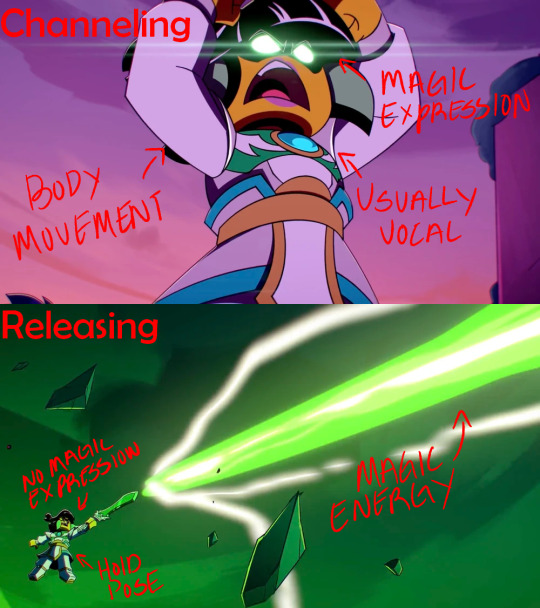
(Mei showcasing channeling and releasing in Rip and Tear) You can always tell when a character is channeling and releasing.
Knowing which class of magic a character is using can be hard — they all tend to utilize anime-esque energy blast graphics and glowing bodies for Magical Expression — so you have to pay close attention. I'll be going over how to identify the specific magic types as we go through them.
Each type of magic has a "poster child" — a character that fully embodies that type — and I'll be using them to explain how the magic works. Once we finish the easily categorized magics, we'll get into the Special Cases.
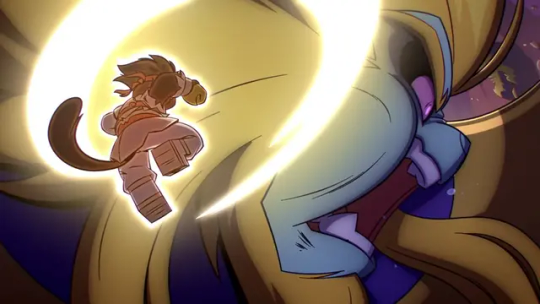
(MK showcasing Intrinsic Magic in Rip and Tear)
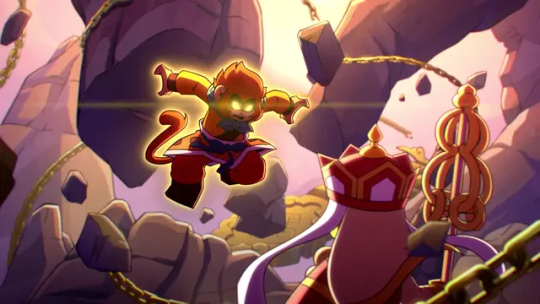
(Wukong showcasing Cultivated Magic in A Lifetime of Mistakes)
Now, onto the classes of magic!
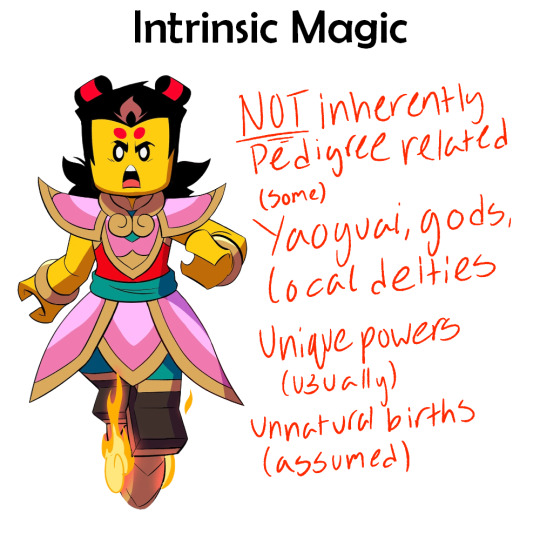
Intrinsic Magic is a class of magic...
That's not inherently pedigree-related. Ne Zha's father Li Jing was a mortal man.
Most gods and local deities have, and some yaoguai have. (Older demons like DBK and Wukong have Intrinsic Magic, while younger demons like Pigsy and Sandy might technically have Inherited Magic. It all depends on how you want to look at it.)
That usually comes with unique powers, commonly the ability to walk and talk upon birth. (Wukong got laser eyes, and Red Son* got the Samadhi Fire).
And holders have unnatural births? Pangu's cosmic egg, Ne Zha being born a ball of flesh after being gestated for three years, Wukong's rock that's existed since the dawn of time, etc.
Ne Zha is the epitome of Intrinsic Magic! If you think Intrinsic Magic, you think Ne Zha. The unmistakable way to identify Intrinsic Magic is to look for themes. If a character has a theme to their magic, again and again, they likely have Intrinsic Magic! For example:
Ne Zha's Intrinsic Theme is (obviously) lotus flowers/petals.
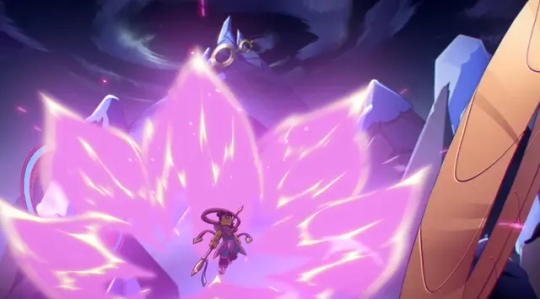
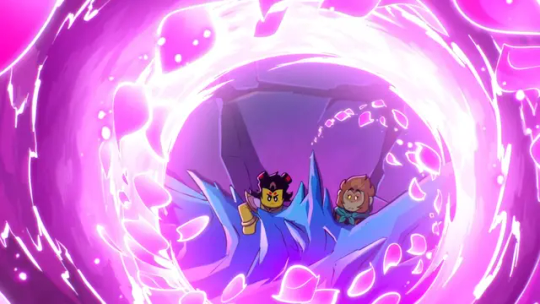
Red Son's* Intrinsic Theme is flames.
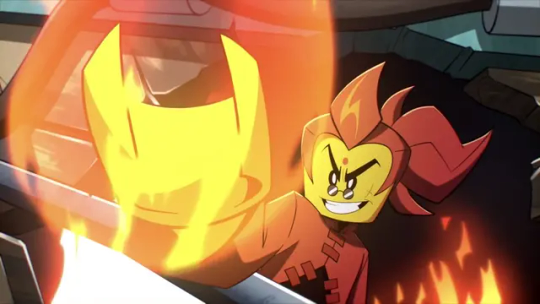
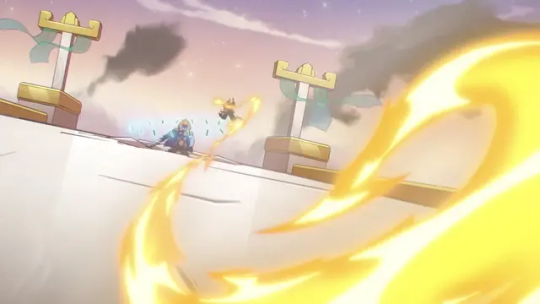
Macaque would be a contender for intrinsic magic (we will be getting back to him, though).

Cultivated Magic is a class of magic that has two subclasses: ACTIVE and PASSIVE, and...
That's ENTIRELY self-created. A magical pedigree can help, but no pedigree is required in Cultivated Magic — Li Jing cultivated magic as a completely human man, for example.
That NEEDS a Conduit. The conduit for Cultivated Magic can be the magic user themselves, but often it's a magical artifact or a technique. Note: a conduit doesn't require Cultivated Magic to be used, but Cultivated Magic requires a conduit. (Known Conduits include: Wukong's Cloud Somersault, Nezha's Wind Fire Wheels, and Princess Iron Fan's Banana Leaf Fan.)
That's very backstory-heavy. There's always a way that a character learned or got their power, or a description of how old they are.
A magic that you see most with yaoguai and immortals. The older the yaoguai, the more cultivated they are.

Passive Cultivation: Every living being is a conduit for passive cultivation — by existing, you are passively cultivating. The best method of passive cultivation is age; the older something is, the more passively cultivated. A Huli jing is the best example of passively cultivated magic. According to literature, the older a fox is, the more power it accrues.
Active Cultivation: Active Cultivation is when a being seeks out magical power. The most common form of active cultivation is being taught Tao techniques (Wukong's Cloud Somersault, Li Jing's Burning Pagoda Art). In this situation, the technique is the conduit. Other forms of actively cultivating magic are yaoguai eating humans and magic-accruing technology (specifically DBK's Furnace armor, which converts rarity into magical energy.)
Cultivated Magic comes with the implication of being wise, at least in some form, and those with cultivated magic are able to teach others. Being a disciple immediately means you have Actively Cultivated Magic.
Cultivated Magic often doesn't have Magical Expression, because it's all about existing and learning. When it does have Magical Expression, it's usually depictions of strength and power or the conduit itself glowing.
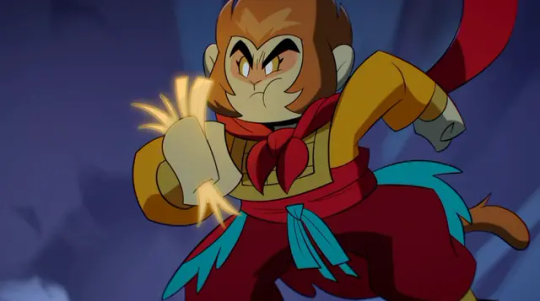
(Wukong's hairs glow as they are used as conduits for his cloning technique in Macaque)
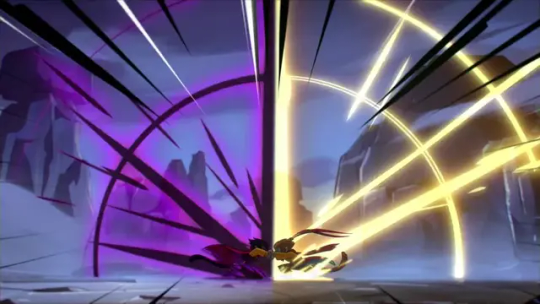
(Wukong and Macaque's strength is showcased through Magical Expression during a fight in Macaque)
Cultivated Magic can be seen through any technique that was stated to have learned, such as Wukong's astral projection and his speed/quick reflexes.

(Wukong focusing in order to astral project to MK in Dumpling Destruction)
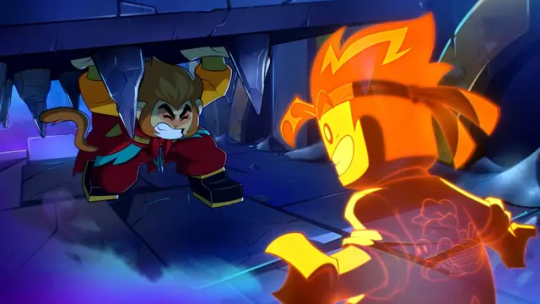
(MK having to actively learn and practice astral projecting in Minor Scale)
MK: Monkey King! It worked! Monkey King: Hey, bud. So, you figured out astral projection, huh? MK: Yeah, and I only had five nose bleeds.
Cultivated Magic is best showcased in action, and characters cultivate over the course of the show.
tumblr
(Wukong showcasing his Cultivated Magic by pulling some fast ones on MK in Impossible Delivery)
(4 seasons later in Strings That Bind, Wukong and MK spar, showcasing MK's Cultivated Magic. Tumblr will NOT let me embed both videos, and the first one is more important, so this will just be a link.)
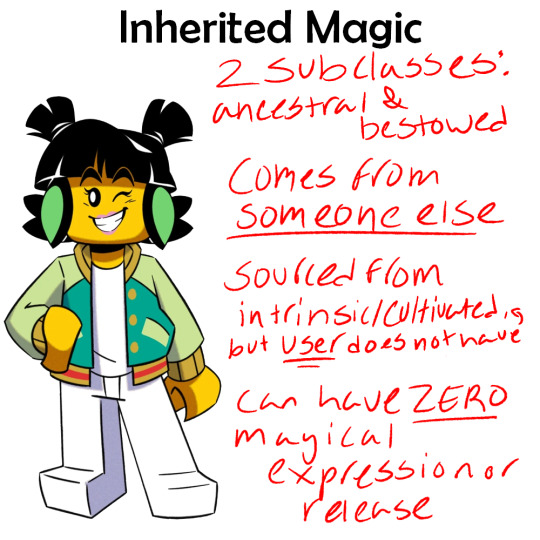
Inherited Magic is a class of magic that has two subclasses: ANCESTERAL and BESTOWED, and...
Comes from someone else and was given to or passed down to the magic user.
Is sourced from Intrinsic or Cultivated Magic, but the magic user is not intrinsically magical/did not cultivate that magic themselves. The Intrinsic/Cultivated Magic is specific to another (perhaps deceased) being.
Can have ZERO Magical Expression or release.

If a character has Ancestor-Inherited Magic, they'll have a family animal, a family artifact, and/or a known ancestor.
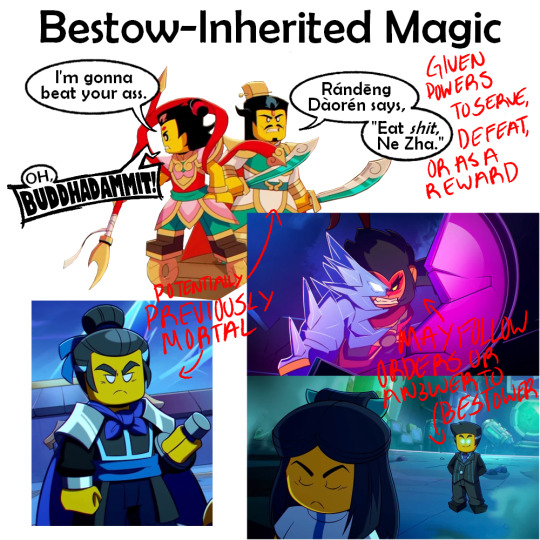
If a character has Bestow-Inherited Magic, they were given their power by another magic user (known as the Bestower) so that they would serve that magic user, defeat a foe, or as a reward. Bestow-Inherit Magic users are often previously mortal.
Bestow-Inherited Magic is most blatantly a character giving another character magical powers, but being granted godhood, being brought back to life under a deal, and everyone receiving heavenly ranks/Wukong and Tripitaka receiving Buddhahood and Buddha titles at the end of Journey To The West is also Bestow-Inherited Magic.
A quick note: Older yaoguai (DBK, Azure Lion, Wukong) are considered to have Intrinsic Magic, but Modern yaoguai (Pigsy, Sandy) are deemed to have Inherited Magic. This is because these younger demons are not yaoguai specifically unto themselves — their status as a yaoguai comes from their ancestors. They have no unique, intrinsic powers, nor were they specifically predestined to be yaoguai despite their heritage (such as in the case of Nezha, who was predestined to be a celestial being).
For example, Pigsy. His status as a Magic User exists because of his family history. While, yes, his family is important to his character and story, it's not something he did himself — he did not cultivate his grandma — and there is nothing unique about him biology-wise besides just being a pig demon. He is a reincarnation, but being a reincarnation didn't make him a yaoguai. (That was a whole fate, symbolism deal, though.) If Pigsy hadn't been born, his family would still have a pig demon kid.
Now, onto the subtypes. (As a reminder, a subtype modifies a class!)
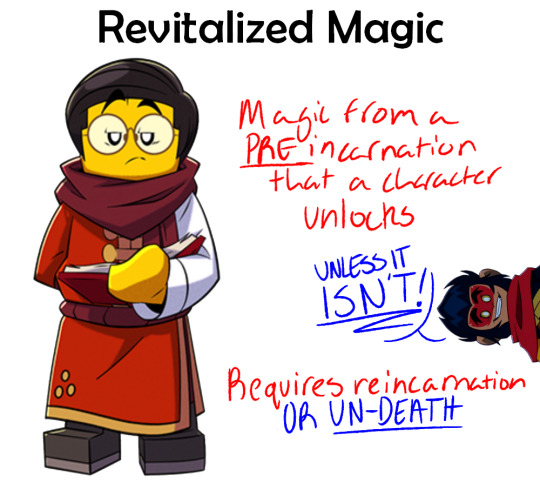
Revitalized Magic is a subtype of magic. It means that the magic is from a pre-incarnation that a character unlocks and requires reincarnation.
Uuuuunless it doesn't, and it required Un-Death. Auto-Revitalization of Magic is definitely a thing, but it's not a real category. It's just a specification to explain things that have happened to a character.
For example: The reason Macaque's shadows turned into chaos magic at the end of season 5 is because he's dead. He's outside of the reincarnation cycle, he's Undead, his magic is Auto-Revitalized —so when the reincarnation cycle is broken, his magic is also changed. At least, that's my personal theory. I might be DEAD WRONG.
Okay, back to Revitalized Magic proper: Remember back when I said Tang's magic was cubed? Yeah, this is why. (Before we start, Táng Sānzàng will be referred to as Tripitaka from here on out.)
The full classification of Tang's magic is: Potential Revitalized Bestow-Inherited (Tripitaka), Revitalized Actively Cultivated (Golden Cicada), Revitalized Actively Cultivated (Tripitaka), Actively Cultivated Magic. (Maybe, we'll get into this.)
The entire reason demons tried to eat Tripitaka was because he was the reincarnation of the Golden Cicada, who was a disciple of Buddha, which made Tripitaka's flesh holy. Being a disciple immediately means Actively Cultivated Magic; Tripitaka had Revitalized Actively Cultivated Magic. Tripitaka was a Buddhist disciple as well, which means he also Actively Cultivated. If Tang is a reincarnation of Tripitaka, who is a reincarnation of the Golden Cicada, then Tang has Revitalized Actively Cultivated Magic twice (or, even, 10 times, if you look at the Sandalwood Buddha thing, but Tripitaka and Golden Cicada are the important disciples so we're only counting them).
If Tang has Revitalized Actively Cultivated Magic and Revitalized Actively Cultivated Magic, that means he has Revitalized Actively Cultivated Magic². However,
Tang is a SCHOLAR. BEING A SCHOLAR MEANS THAT TANG IS ALSO AN ACTIVE CULTIVATOR.
HENCE, TANG HAS ACTIVELY CULTIVATED MAGIC³.
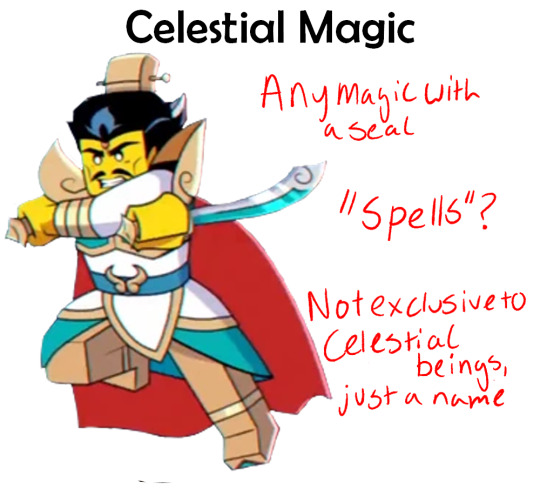
Celestial Magic is a subclass of magic that includes any magic with a seal. It's not exclusive to Celestial beings, but it's most often used by beings with Heavenly connections.
Celestial Magic is also known as "Spells", I'm pretty sure. Wukong just dropped this terminology on us in Season 5, and spells usually require words, but like. Okay, buddy. Whatever. You're the magic guy.

Celestial Seals have a unique symbol for every "Artist", or a Hànzì that explains the spell's purpose. For example, Li Jing's seals have a little pagoda on them, and the containment spell's seal (the only thing that can truly be called a spell here) has the character "牢", which means "prison" (or "enclosure", which is hilarious because it's containing 3 monkeys).
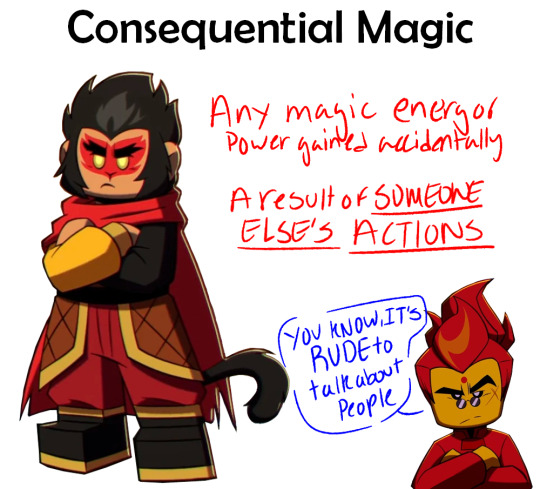
Consequential Magic is any magical energy or power gained as a result of an action taken by someone who is NOT the magic user.
Consequential is not a subclass of Cultivated because the magic user had no say in acquiring/did not know they were acquiring Consequential Magic; Consequential is not a subclass of Inherited because the magic user was not intentionally given these powers and they did not come from ancestry.
(Red Son* is literally the reason this subtype exists.) Every example of Consequential Magic is different, so I'm just going to some of the ones I know of in canon:
Wukong's Golden Sight (Consequence of the Eight Trigrams Furnace; Torture-consequence)
Ao Lie having the Samadhi Fire inside him after they fucked up the seal (Samadhi Fire/Red Son*; Samadhi-consequence)
Mei Dragon's ability to harness the Samadhi Fire/the remnants left over inside her after (Samadhi Fire/Red Son*; Samadhi-consequence)
MK's human form (form as in the shape of something btw) (Xiangliu fucked his shit up; Birth Interference-Consequence)
Macaque's new Chaos Magic (Xiangliu fucked his shit up; Chaos-Consequence)

I have spent this entire post explaining the way magic seems to work in LEGO Monkie Kid, getting slightly more and more unhinged as we go on. But there might be two things on your mind: Why? and Why does Red Son's* name have an asterisk on it every time I've mentioned him in this post?
I can answer both of those questions with one statement: Red Son does not adhere to the magic rules other characters follow. I've tried to find examples to see if I was thinking of the magic wrong — and that's fully possible — but I didn't find anything. In fact, the more I look, the more sure of this I become. It's like he actively decides against following the rules of the magic system.
He can be used as EXAMPLES of the magic system, but when you dig into his magic specifically, it's completely wack-a-doo.
First and foremost:
Red Son has a completely unique form of Magic Expression. His emotions are directly linked to his Magical Expression and release.

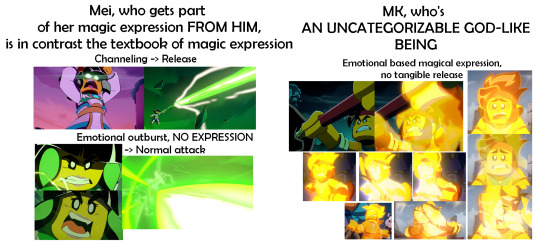
Emotionally linked magic release is something no other character does, but here he is doing it over and over and over again. The only example close to it is MK's Mystic Monkey form flickering in and out when he's distraught, and that's LITERALLY CREATION-GIVEN NÜWA MAGIC, THAT'S FROM A CREATURE WHOSE CANONICALLY "OUTSIDE OF THE 10 SPECIES" AND CANNOT BE CATEGORIZED?? AND ALSO NOT QUITE THE SAME EITHER.
(This could also be attributed to the concentration part of the Samadhi Fire, but he doesn't... seem to have access to that anymore? At least, not like Mei does. We'll consider it a factor in his magic expression, though.)
About his fire,

Red Son and his mom are the only two characters with Wuxing/Elemental Magic — every other example comes from a magical artifact. It's actually a 50/50 chance on whether or not PIF has wind powers or if the Banana Leaf Fan gives her wind powers (I'm pretty sure it gives her wind powers, but just to be safe we'll count her as having wind powers.) Wuxing Magic is not uncommon in actual Chinese mythology, but it is in the show for some reason. And it ALWAYS has an artifact as a conduit. Wuxing Magic always seems to be just a visual effect or an added addition to attacks in the show.
Another weird ass thing about Red Son's magic is its contrast with Nezha's. I'm pretty sure Red Son's fire is actual fire that he conjures magically, in contrast to Nezha's Wind Fire Wheels (conduits that Nezha fuels, and release Wuxing Magic as a visual effect) which make specifically magical fire.
Okay, so, I've been going through this assuming you're aware of the show's visuals concerning magic, but this is important for me to cover in detail. Everyone has two magic colors (white doesn't count for this). They can change in lighting, but you'll always recognize them as being the same general colors. Other colors may be used for emphasis, but they'll only be darker versions of the colors and they'll be used as a background for the main colors. (Quick note, MK and Wukong might have only one magic color? Fun stuff.)

The reason I think Red Son's magic is not... magic persay, is because it doesn't follow the color rule. Like, it's not actually the color of Red Son's magical energy half the time, it doesn't follow the magic color rule. Red Son's fire shifts like an actual fire, which is very cool visually, but is not how magic works.
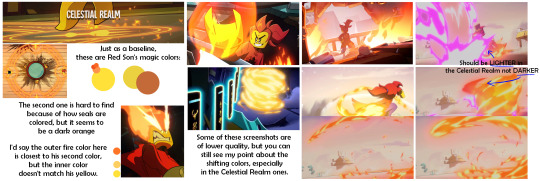
(Quick note, magic seems to be lighter in the celestial realm. This is because the Celestial Realm is really well-lit. The environment is literally pure sunlight or some shit, so all the characters and their magic are in perfect lighting. So Red Son's magic getting inexplicably darker would make no sense unless Red Son's magic is doing that on its own and the lighting has nothing to do with it.)
His magic also isn't the color of the Samadhi Fire, nor is his fire. That time in season 5 when Mei helped him with the seal, the two of them together made a Samadhi Fire-colored seal. He didn't seem capable of doing that by himself, which leads me to my conclusion:

I think the suppression of the Samadhi Fire suppressed Red Son's Intrinsic Magic as a whole, and his magical core (as one user put it) is compensating by drawing directly from his element.
Characters having an element isn't a new thing. Wukong's element is metal, he's a metal guy, it's why he can't swim, and it's why MK can't swim. MK needs floaties because he'll sink like a rock because he shares the metal element with Wukong.
But this is a possible explanation for why Red Son's magic is so weird.
On the note of Mei having more access to the Samadhi Fire than him, Skellebonez (my rock through this journey of a post) brought up a good point: "[I] think it makes sense because whatever they did to remove it from him could have also added a barrier preventing its return to an extent[.] Like a filter[.]"
This Intrinsic Magic cap/Samadhi Filter might also explain why he keeps getting his shit rocked despite having such potential to be powerful (that's probably just because it's silly tho) and it could explain why his parents are so damn disappointed in him in season 1. It's because they took his magic from him (however unintentionally) and he's not as magical anymore. The only type of categorizable magic he uses is Celestial magic, which HUMANS can use and can be bestowed on ANYONE. You can just like... LEARN THAT, and I think he just did.
In canon, nobody ever seems to be hurt by Red Son's fire? It seems to just be... a thing that he does. Everyone is less and less scared of it as the show goes on, and the only thing it does major damage to is MK's apartment. He uses his fists to attack more than he uses his fire, it's generally left as a visual effect. Red Son uses his fire as an intimidation tactic, not as an actual weapon, and I think this could also be explained by an Intrinsic Magic cap. His intrinsic magic is suppressed, so he has to rely on things like physical strength/cultivation.
I also think nobody knows this in canon, they didn't know about it, or they don't understand it. I think Red Son has a magic limiter on him, which is why his parents were such raging fuckasses in season one. They thought their son was "useless", or in Wukong's words, "half-baked", after showing such promise in his childhood before an incident. They only got a healthier relationship after they stopped obsessing over power and spent some family time together, when they realized that their son being a powerful magical demon isn't the most important thing in the world. (AND WE WEREN'T SHOWN IT.)
Red Son is magic-disabled, in this essay I did.
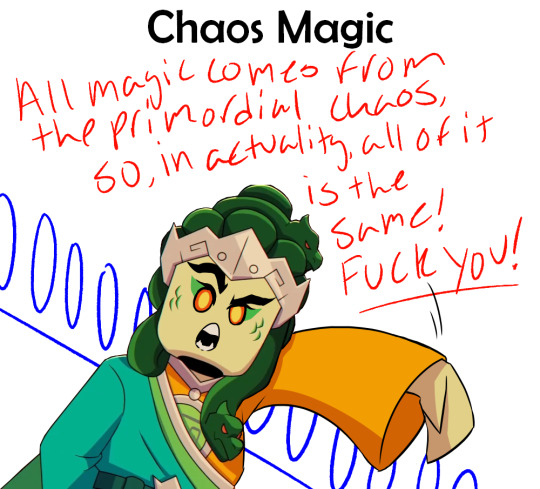
ALL MAGIC COMES FROM THE PRIMORDIAL CHAOS, SO, IN ACTUALITY, ALL OF IT IS THE SAME! FUCK YOU!
#sav rambles#long post#long reads#magic system#analysis#magic analysis#world analysis#character analysis#lego monkie kid#lmk#monkie kid#fantasy#lmk nezha#lmk monkey king#lmk mei#lmk li jing#lmk tang#lmk macaque#lmk nine headed demon#lmk red son#red son#actually disabled#sorry you're ableist PIF it's in character#sorry you're ableist DBK it's in character#THIS WILL MAKE SENSE IF YOU READ THE POST LMAO#HAH#THIS ONE IS A ROLLERCOASTER#This took me literal weeks#there are pictures!#and videos!
395 notes
·
View notes
Note
I noticed that people keep saying that Kalim, Silver, and Rook, use light magic (which i know is because they are based on good guys), and the others use dark magic (because they are based on villains). I'm..confused on what exactly that means. It doesn't mean the magic the villain based characters use is evil, right? I'm asking because the story states that Azul's UM is seen as "taboo" so I at first thought that "taboo" magic was considered dark magic. You would've thought that something like Ruggie's or Jamil's UM would be considered "dark" or "taboo" but I feel like that's another can of worms. I just have some questions, and I'm not sure if there are canon answers, but I would love to know what you think. What exactly is considered dark magic? How do people learn to use light or dark magic? Are people who use this "dark magic" more likely to overblot?



“Light” and “dark” magic refer to the fandom-given (not official) classifications for the Null/Cosmic spells the playable versions of the boys produce. (Those are the grey colored spells!)

Kalim, Rook, and Silver are the only three characters that uses “light” (yellow) Null/Cosmic attacks in battle.
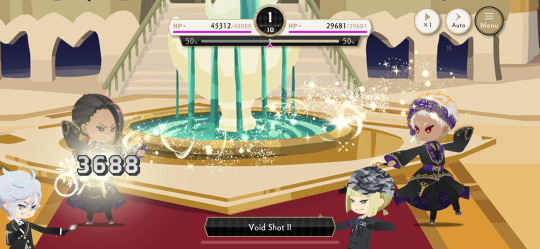


Everyone else uses “dark” (purple) Null/Cosmic attacks:

Again, these “light” and “dark” magic classifications come from Twst fandom and are not actually used or acknowledged in-universe or in official Twst materials. The fact that it’s the three “good” or “non-villainous” NRC characters that have light Null/Cosmic spells is also from fandom.
Another variant of this theory suggests that the so-called “Light Trio” enrolled at NRC in atypical ways, but this is only true for Kalim. He transferred into NRC a few months in and with financial help from his dad. Silver and Rook were enrolled via normal means as far as we know, although Rook did transfer dorms later.
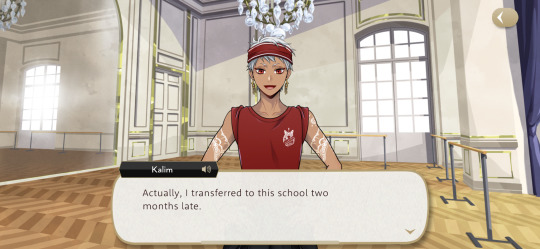
So 😅 there technically is no official meaning for what “light” vs “dark” magic means. These are unofficial terms and only have meaning and relevance within fandom and its theories.
In-universe, light magic is not treated like something exclusive to Kalim, Silver, and/or Rook. It's a simple spell that the common mage can use. For example, Jamil uses magic to light the way in darkness, despite his Cosmic/Null affinity being the purple-colored/"darkness" magic in battles. There are also multiple instances of NRC students like Malleus and Ace making fireworks or achieving a similar effect using magic.

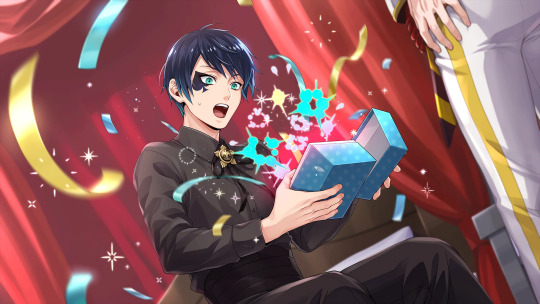

Magic in the Twst world is NOT classified into “good” or “bad” categories. Night Raven College (+ the other arcane academies), other institutions, and individuals do not teach or learn “good” and “bad” magic. Whether magic is “good” or “bad” depends largely on how it is used and the intent of the mage casting the spell. For example, positive/negative intent is what determines if bestowed magic is a “blessing” or a “curse”.
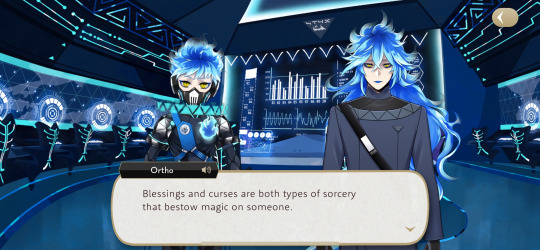
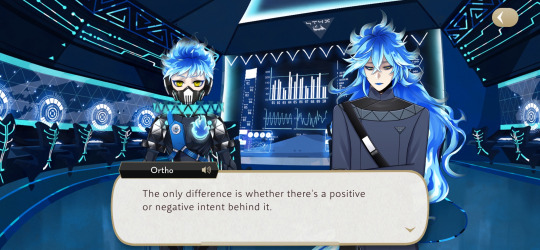
As examples, Idia and Malleus both reframe their perspective on their own magic. In book 6, Idia refers to the power to burn blot (passed down in his Shroud blood) as a “curse”. However, he later calls this power a “blessing”, as it allows him to endlessly cast magic, since his body basically burns it away instantaneously. Malleus, conversely, calls his immense magical power a “curse” that isolates him and forbids him from openly expressing emotions (otherwise this could change the weather and endanger people). Early in book 7, he uses his UM to grant his classmates a “blessing” in an effort to prevent his loved ones from leaving.
Leona does refer to Azul’s UM as “taboo”, though it’s not certain what aspect of the magic is “taboo”. If Leona means that it’s “taboo” to take away someone’s power or to suck out their power, then how come Ace’s UM—which allows him to swap magic with someone else—or Rollo’s actions with the fire lotuses are not labelled the same thing? Maybe this was careless wording on the part of the early main story writing.

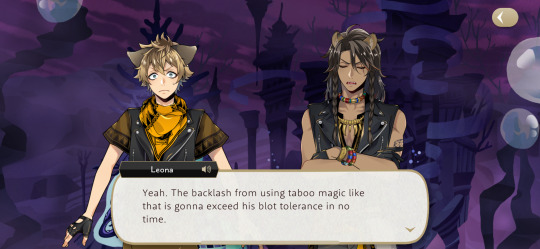
In Malleus’s Dorm Uniform vignettes, he uses a spell typically cast on items to teleport his fellow dorm leaders to him. The others indicate that this is highly rude, as Malleus is treating them less like peers and more like objects.
This doesn’t appear to be the same as so-called “taboo” magic; the issue here is how the spell is used, not that the spell exists at all. It implies there is etiquette around spells and that some require consent so as to not be considered rude.

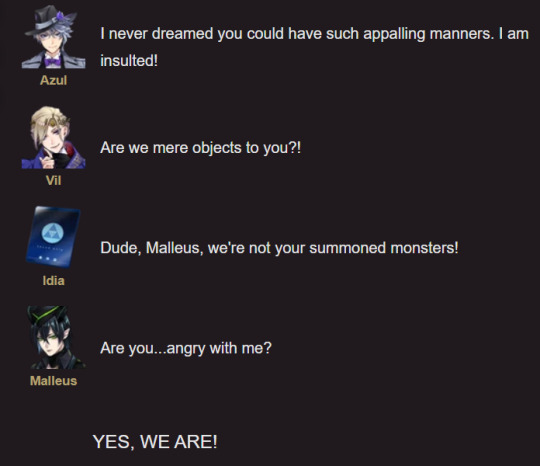

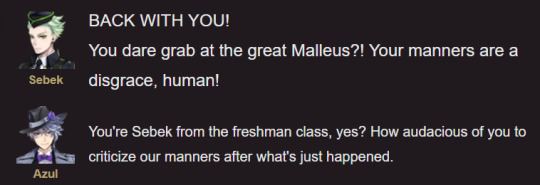
It’s strange to consider that apparently taking magic from someone else is considered “taboo”, but spells which involve control over others or removing an individual’s autonomy aren’t viewed that way. Instead, the most we get is the lore that mind manipulation takes a high degree of skill and magical ability.
The presentation makes it sound as though it’s an incredible feat to be in awe at, not something to be scorned or banned when… shouldn’t you very obviously regulate that in case it leads to mages with this power (few as they are) abusing it? This is especially odd given that the main story points out to us that Azul and Jamil’s UMs demand similar amounts of skills and power to pull off. What makes Azul’s magic “taboo” but Jamil’s not?



Transformation potions and magical medicines/potions are regulated by the government. I’m sure as to why it seems like “taboo” magic like Azul’s or potentially dangerous magic like Jamil’s or Ruggie’s are not also regulated. It really feels like they should be.
As for the impact on blot accumulation 💦 again, there is no true “light”/“dark” (good/bad) magic dichotomy in canon. Blot accumulation is based on the individual mage, their abilities, and their limits. It’s not based on whether their spells are arbitrarily labelled as “good” or “bad”. For example, Kalim’s UM allows him to summon a lot of water for only a little bit of magic. For another mage, it could take significantly more magic to summon the same amount of water. In this case, the other mage could accumulate more blot, regardless of their reasons for summoning that large amount of water.
I know that wad s lot of information, but I hope this all made sense ^^ Let me know if you would like any clarification!
#twisted wonderland#twst#disney twisted wonderland#disney twst#Silver#Rook Hunt#Kalim Al-Asim#notes from the writing raven#question#book 6 spoilers#book 7 spoilers#Idia Shroud#Malleus Draconia#Leona Kingscholar#Azul Ashengrotto#Ruggie Bucchi#Ace Trappola#Rollo Flamme#glorious masquerade spoilers#Malleus dorm uniform vignette spoilers#Jamil Viper#Scarabia
137 notes
·
View notes
Text
A Reflection on Translation's Role in R. F. Kuang's Babel or the Necessity of Violence
I don't think I've ever encountered a work that pairs messages I so completely agree with and an execution that I so profoundly dislike. What a frustrating combination.
I'd had this book hyped up to me by colleagues in the Jp -> En media translation field, and I went into it with the impression that it was an adult fantasy/dark academia novel. I don't read much dark academia--the genre doesn't tend to do much for me--but due to a stroke of unfortunate timing had read dark academia's posterchild, Donna Tartt's The Secret History, just before this, leading me to draw unfavorable comparisons between the two. Furthermore, despite its marketing, Babel strikes me as much more of a YA novel--or at the very least pure pop fiction--and inherits many subjectively negative traits from this classification. Too high expectations, a dislike for the book's genres, and a greater understanding of translation theory than the lay audience--I was never a part of Babel's target audience and had little chance of being perfectly satisfied with it.
Nevertheless, I do think the book has tremendous value to those who aren't translators/translation studies academics or who enjoy dark academia pop fiction. While I don't read much English pop fiction, my subjective lack of enjoyment is not a statement of objective lack of value in this type of literature. I would highly recommend this book to anyone with even the slightest interest in language's effect on the world, and I commend R. F. Kuang's ability to deliver Babel's important messages to a wide audience.
At the same time, the book's status as a translation of 18th century events to a modern audience is fascinating and bears looking at, particularly in how this framework serves to undermine the characterizations and, consequently, the novel's core messages.
The Basics of Babel (Beware of Spoilers!)
Babel is, first and foremost, a medium to deliver certain key messages. The pursuit of empire is inherently evil; when the ones in positions of power will never listen, violence is one of multiple necessary tools; together we stand, divided we fall; spheres of oppression overlap in intersecting patterns; revolutions disproportionately affect the already disenfranchised; even so, structural change is necessary to alleviate structural ills; academia appears to be disconnected from the real world but has real, lasting impact. And so on. I agree (as would, I assume most of this audience--I don't think any of these ideas are especially challenging) with all of these; I'm also not trained in these fields and don't have much to comment on here.
Of secondary importance and primary prevalence in the novel are messages about language. Translation is both a tool of violence and liberation. There is inherently a degree of "betrayal" (the book's term) or "transformation" (mine) in all translation. Language and translation have real effect on the world and its individuals. It is impossible to translate with absolute fidelity and yet an absolute necessity to try. Translation--and by extension, all communication and all human contact--is the necessary violence expressed in the subtitle.
And again, I agree! I agree so completely I struggle to remember a time these themes weren't so self-evident to the point of being part of my self. Where my disagreements begin to creep in occur at the level of the characterization where, by virtue of being flattened in the "translation" process, the characters are inadvertently dehumanized to the degree of undermining these core concepts.
Babel consists of two distinct segments, the former being a 400-page sprawl of the four protagonists' upbringings and undergrad experiences in 19th-century fantasy Oxford as translation students. In this universe, magic is performed by matching a pair of words with the same denotative meaning in two different languages. The unshared secondary meanings or connotations are then manifested into the real world, thus implementing the spell. As a simple example, an English watermelon is not an English vegetable, but a Japanese スイカ is a Japanese 野菜. Therefore, if 野菜 and vegetable were matched, this spell might latch onto the notion of a watermelon/スイカ--something that exists in the Japanese definition but not the English definition--and make the melons grow faster. The protagonists thus spend the bulk of the novel learning translation theory, spell crafting, and the ways in which the British Empire is built upon the back of these spells and global exploitation.
Tensions slowly ramp up until one protagonist ultimately murders another, at which point the somewhat doddering pace revives and proceeds at a brisk clip for the last 130 pages while the surviving pair of "good" protagonists stage a revolution out of Oxford's translation magic hub. While the revolution ends in death for all but two of the "good" characters, it is implied that the revolution's aims are largely successful, with the bulk of the British Empire's spellcasting abilities destroyed. This latter segment of the story has some of the same juvenile, almost fairytale-esque simplification of the rest of the book (it's a tempting fiction to believe the destruction of a single building by a small handful of elites could bring an empire to its knees; this book ultimately reads as an academic's power fantasy), but I actually quite like it compared to the rest of the book. The narrative finally grants the main character some much-needed agency, the characterization improves by leaps and bounds, and the protagonists' views are at long last explored with contrasting and three-dimensional opinions. It's a welcome breath of fresh air and complexity.
The problem, as I see it, is that because Babel tackles such critical and multi-faceted ideas as the ethics of revolution and translation, complexity is a necessity that Babel too often forsakes. Babel flits between the competing notions of an educational call for action spoken by real, imperfect people and a cozy, somewhat twee fantasy of paper dolls coming together across racial, gender, and class lines for justice. If the work wants to discuss dehumanization via language, it can't afford to dehumanize its own characters with its language.
Babel as Translation
Kuang's narrator and narrative work hand-in-hand to produce this uncomfortable and clumsy effect.
The book is framed as a historical text written by a minor participant in the revolution in an effort to humanize the characters, "a record that doesn't make us out to be the villains." (504) This aim is achieved as Kuang's narrator follows the internal life of Robin Swift and, to a lesser degree, the three other members of his Oxford cohort in dramatic fictional prose. The text is peppered with footnotes providing extra context, much like a translator's gloss, generally about historical injustices but with occasional dips into the protagonists' private thoughts. The narrator themself, while content to remain in third-person, injects their personality heavily with didactic commentary on oppression and translation theory. I don't knock this as a storytelling technique in and of itself; a brutal hammer of a narrator could be an interesting parallel to the brutal hammer of systemic oppression. It does, however, create the impression that the narrator is hovering just over the story's shoulder at all times, unwilling to trust that the characters will perform their allotted roles once the narrator's back is turned.
Furthermore, the narrator's voice is firmly grounded in its time and place--the time being 2022 and the place being the leftist internet. The prose is undeniably the rhythmic, somewhat dramatic style presently in vogue in the English fiction market, and arguments are formed in the thinking patterns and vocabularies of modern day English internet discourse. When the work itself is set in the 1800s, this creates a slightly jarring effect--language supplanted into a setting where we wouldn't expect to see it.
This suggests the narrator is, effectively, translating a series of events written in an older English into the English of our day and age.
We must assume the narrator is taking their fair share of liberties. Apart from the inclusion of vocabulary that's wildly anachronistic (the word "narcostate" would not materialize in English until long after the 1830s), we also see the narrator's presence in the similar speech styles of all English-speakers across place of origin, class, and upbringing. Compare the college-educated Robin:
But how do you know? ... You didn't see what I saw, you don't know what the new match-pairs are-- ... It's just... It just feels like--I mean, I'm the only one who's always at risk, while you're just-- (182, quotation picked somewhat at random)
to the working-class laborer Abel:
"Is it really as bad as all that?" Robin asked Abel. "The factories, I mean." "Worse," said Abel. "Those are just the freak accidents they're reporting on. But they don't say what it's like to work day after day on those cramped floors. Rising before dawn and working until nine with a few breaks in between. And those are the conditions we covet. The jobs we wish we could get back. I imagine they don't make you work half as hard at university, do they?" (493)
Similarly, most characters retain the same vocal quirks as the narrator and Robin. See also on page 493, a third character starting and stopping herself in an identical fashion to Robin, "It's just... it's a side of the story we don't often think about, is it?" or on page 529 the same character copying Robin's habit of amending her comments with I mean, "Possibly the younger students... The ones who don't know any silverworking, I mean."
This produces a muted, washed-out effect wherein characters struggle to differentiate themselves on the basis of their personalities. But, in terms of translation, is this necessarily a bad thing? Is it wrong to familiarize the unfamiliar with the vernacular of the target audience?
Fortunately for us, Kuang's narrator has their own opinion on this very subject, delivered to us through the mouth of Ramy, Robin's love interest and generally all-around "good" character. In fact, one of the very first things we learn from Ramy is his dislike for a certain style of translation:
That's a terrible translation. Throw it away. ...and for another, it's not remotely like the original. What's more, Galland -- Antoine Galland, the French translator -- did his very best to Frenchify the dialogue and to erase all cultural details he thought would confuse the reader. ... And he entirely cuts out some of the more erotic passages, and injects cultural explanations whenever he feels like it -- tell me, how would you like to read an epic with a doddering Frenchman breathing down your neck at all the raunchy bits? (52)
Blessedly, we are spared that specific experience--if any raunchy bits existed, Kuang's narrator has trimmed them accordingly.
The reader, at this point, is expected to know little of translation theory on their own and should accept Ramy's opinion as that of fact. Ramy is the first character with purely positive associations in Robin's life, and the narrative swiftly propels us through the process of Robin and Ramy falling in love within a handful of pages. ("Robin felt a strange, bursting feeling in his chest then. He'd never met someone else in this situation, or anything like it..." (50) "...they sat cross-legged on the floor of Ramy's room, blinking like shy children as they regarded each other, unsure what to do with their hands." (50) "And [Robin] wanted so badly to impress Ramy. [Ramy] was so witty, so well-read and funny. He had sharp, scathing opinions on everything..." (51))
The reader is therefore expected to associate a liberal or heavy-handed translation style with bad practices--that is, until we learn that Ramy himself "was always ready to abandon technical accuracy for rhetorical flourishes he insisted would better deliver the point, even when this meant insertion of completely novel clauses." (224) (We must also note that this is the "polar opposite" of a "bad" character's style, which we will touch upon shortly.) Ramy, it seems, is allowed his liberties because he has "an uncanny ear for rhythm and sound. He did not merely repeat the phrases he absorbed; he uttered them in such precise imitation of the original speaker, investing his words with all intended emotion, it was like he momentarily became them." (269) Meanwhile, on page 383, we are told "Non-European texts [translated into English by Europeans]...tended to be loaded down with an astonishing amount of explanatory content, to the effect that the text was never read as a work on its own, but always through the guided lens of the (white, European) translator." This information might have been better received were it not in an explanatory footnote that takes up the half page.
I would like nothing more to give Kuang the benefit of the doubt and assume these hypocrisies are intentional, but writing a heavy-handed 500-page book just to poke fun at heavy-handed translation in a single footnote is either a Modernist masterpiece or simply not happening.
I also understand and acknowledge that there is plenty more nuance to these arguments. The Galland translation of One Thousand and One Nights bears a strong moral impetus toward exact fidelity as an introduction of a work of enormous cultural value to a society largely ignorant of that culture; Ramy's translation is a college writing assignment. Elisions for cultural sensitivity are not the same as additions for aesthetic sensibilities or contextual glosses/footnotes. Kuang's narrator is translating concepts from an academic environment to a general audience, where the balance of power is relatively equal, whereas Galland is translating across a broader power gap between cultures. Etc etc. I don't take umbrage with any of that--I also think Galland's translation practices were unacceptable, and I'd be a fool to pretend I don't take translation liberties when appropriate. My concern is that the general audience lacks this background and, when asked to reconcile these hypocrisies, will draw the conclusion that Kuang's narrator is espousing "white, European = bad / non-white, non-European = good."
Which, in the broadest brushstrokes of this colonial environment, is true! The British Empire--and empire in general--is cartoonishly evil, and I don't care much that most of the white English cast is flattened into 2D caricatures as a consequence. It's the reverse that's far more troubling.
Unfortunately, for the first 400-some pages of the book, the narrator plants all intelligent, kindhearted, or otherwise pleasant thoughts in the heads of non-English characters. (Here, non-English refers to any PoC character born outside of Britain, any half-white characters, and the one "good" Irish character. "Non-English" is a terrible classification system, but as all the "good" characters don't self-identify as British or English anyway, this will have to do for now.) Arguments between non-English characters are astoundingly minor; worse, they have little to no bearing on the overarching plot--it takes the murder of a white man to turn the story from academia romp to goodnatured revolutionary conspiracy. (And this only boils over into full revolution because a white English girl takes negative action!) Non-English characters' worst traits are annoying at best to the point where one, their repeated inability to understand intersectionality, comes across as bizarrely out of character and inappropriately dim-witted. Even then, such comments are set up to be angled at "less oppressed" characters. Robin and Ramy frequently fail to conceptualize the struggles of their female classmates or, at times, have rude thoughts about women. However, when their black female classmate Victoire is having anxiety attacks and white female classmate Letty is suffering nervous breakdowns, Robin ignores Victoire to say Letty is "not helping the general feminist case that women were not nervous, pea-brained hysterics." (368) Victoire simply cannot allowed to be "bad" in any way.
The constant need to be "good" strips characters of any ability to develop personality, deep character flaws, or culpability for their actions. For 4/5 of the book, Robin, Ramy, and Victoire are so caught in the narrator's stranglehold that they appear only little more three-dimensional than the paper-thin villains. This, while unintentional, is nevertheless a tragedy.
The Translated Narrative
Similarly, the narrative suffers from being a modern day experience transplanted onto the 19th century setting.
Protagonist Robin and the other members of his cohort are introduced as linguistic geniuses, all of whom have studied from a young age--and not always willingly--to be part of an elite class of undergraduate translators at Oxford. From the age of eleven, Robin spends hours every day studying Greek and Latin, both of which have historically been taught and to this day are taught with copious amounts of translation work. We are shown Robin translating Latin into English as a child (31)--amusingly, the author he works on will be complained about later as very difficult to translate when taught in the later years of undergrad, an inconsistency I can only assume is unintentional--and have every reason to believe it is done competently. Furthermore, Robin continues to retain his native fluency in Mandarin, meaning he should be intimately familiar with basic translation theory and the differences in language by the time he reaches university.
However, the modern day reader is not expected to share this same linguistic background, and the narrative must quickly bring them up to speed. Thus, upon arriving at Oxford, the narrative takes the audience on a ride through a series of bare-bones basic translation theory lectures.
The first lecture opens on the professor "try[ing] to impress upon [the protagonists] the unique difficulty of translation," (104) an absurdity when presented to characters who have been translating for years. Suddenly, characters are catapulted out of their 19th century elite backgrounds and into the bodies of 21st century freshman.
"I don't understand," says trained classicist Letty. "Shouldn't a faithful translation of individual words produce an equally faithful text?" (105) (Later, we discover that Letty's translation style leans strictly literal in opposition to Ramy's. This is posited as a bad choice--which is broadly speaking true--but becomes an uncomfortable parallel between Letty's unyielding, "bad" personality and her "bad" translation choices. Ramy also equates being a good listener and with being a good translator (535), leading to one of the few places where I openly disagree with the narrator. In an ideal universe, truly good translation could only be unlocked with great care; unfortunately, technical skill does not equal strength of character.)
"Is faithful translation impossible, then?" a professor later "challenges." "Can we never communicate with integrity across time, across space?"
"I suppose not," reluctantly (153) says Victoire, who is "raised to read and compose and interpret." (541)
The notion that these characters can have drilled in languages and translation for years on end without having ever considered these basic concepts is laughably absurd. It is like an engineering student receiving a full-ride scholarship to MIT, walking into class on the first day, and saying, "What are all those letters doing on the board next to the numbers?"
And yet the narrator would have us believe this because, fundamentally, the narrative is that of a 21st century university undergraduate's experience. Someone with an interest in languages but little formal training in translation--we certainly don't teach that in American high school--could, conceivably, walk into these lectures and be charmed by "this dramatic mysticism, these monologues that must have been rehearsed and perfected over years of teaching. But no one complained. They loved it too." (107)
Our imaginary 21st century undergrad takes Robin by the hand and leads him along four years of lectures, luncheons, exams, rowing club, and endless giggle sessions with friends. It's cozy and cute. Everything is magical and ready-made for a Pinterest board.
Meanwhile, the bloody cogs of the British Empire churn relentlessly in the background. Robin is invited to participate in a largely low-stakes revolutionary operation and, for about 200 pages, most of his inner turmoil centers around the conflicting desires to lean into the revolutionary movement and the desire to cement himself in a cushy life at Oxford.
Here, the lighthearted atmosphere is by design; for the modern-day reader to feel shock at the abrupt turn in tone, the luxuries and conveniences of an idyllic modern-day academic experience must be shown. However, it must be stressed that this tonal shift occurs over 400 pages in. The slow pace hinders the narrative's ability to be considered in its full 19th century ramifications. We spend so long in Robin's 21st century head that the core struggle, for a sizable chunk of the novel, is coming to terms with one's position of privilege in society and how that affects one as a translator. These are valuable things to consider, and it is something the audience--most of whom are closer to Lettys than Victoires in terms of societal position--should devote time and attention to, but I cannot help thinking there could've been more efficient use of space in this book. It is difficult to examine more of the hard-hitting topics when so much of the book is devoted to the author's nostalgia for their college experience.
The narrative's other core issue interweaves with something I touched upon earlier, the lack of agency in its core characters. For most of the book, Robin is largely shepherded along by forces outside of him, giving him an (intentional) learned helplessness under the oppressive colonial system. However, likely unintentional narrative choices contribute to this problem and give Robin the impression of being even less empowered than he is meant to be. Robin's first two decisive actions of any note are triggered when another character forces him to make an "It's us or them" style choice. In both cases, Robin chooses to side against the revolutionaries for self-motivated reasons, and the narrative later rewards him with a third "It's us or them" choice motivated by purely selfless desires. These could be great character-establishing moments--if any of those choices mattered. But they don't! After choice 1, Robin winds up in contact with the revolutionaries again due to complete coincidence. After choice 2, Robin faces the personal fall-out of turning in the revolutionaries...until a more pressing issue turns up, only partially of Robin's doing (the question of whether this was intentional or accidental is discussed heavily throughout the rest of the book), at which point the personal issues dissolve and vanish. Oh, and the revolutionaries suffered no consequences after Robin ratted out their safe house. Everything is fine and dandy!
And also deeply frustrating. If Robin's actions don't matter, then why have Robin act at all? Is Robin a person or a cardboard cutout doll?
Similarly, the narrative is littered with deus ex machinas to an unfortunate degree. The reader quickly becomes accustomed to a common narrative structure: A problem presents itself, the protagonists panic and make an attempt to fix the problem, that solution fails, tension heightens--and a side character (often a revolutionary) steps in and resolves the problem. So, too, are the major turning points orchestrated by other people. Robin's father instigates his own murder by approaching Robin. Robin is radicalized by Letty setting the police on the revolutionaries.
Robin, then, has no more control over his person than a puppet until the final 1/5 of the book. This is partially intentional as a means to demonstrate Robin's unconscious conforming to racial stereotypes of passivity as a means to be "accepted," even partially, in colonial British society. Had this vanished entirely upon Robin's dramatic turn to agency in the final hundred pages, I wouldn't have been the slightest bit concerned--but it doesn't. Once Robin seizes control of the magical translation tower on page 448, he sits and waits for outside forces to act. And waits. And waits. And waits. The army arrives, but that's all right, because here come the townspeople, who've made a miraculous turn of heart and are ready to be good revolutionaries alongside the Oxford elites. Oh no, they're running out of food--oh, whew, the problem solved itself by virtue of the townsfolk showing up. Uh-oh, Robin has to make the decision of breaking the siege under flagging moral--oh never mind, here comes Letty to take that problem away. I can't wait for Parliament to respond and end the siege for us, but until then, we just all have to wait. And wait. And wait.
It is 84 pages before Robin takes another action.
Translation as Necessity
I don't fault Kuang for the ideas she presents, nor the means she chooses to employ, but I do think it's a tragedy that her own writing skills are inadvertently undercutting her work. Babel is, at heart, a heavy translation of a fictional 19th century event that accidentally does the very thing it criticizes--making people less than people through the act of translation.
And yet still we must translate.
Kuang is correct and expresses herself elegantly when her narrator says:
Language was just difference. A thousand different ways of seeing, of moving through the world. No; a thousand worlds within one. And translation -- a necessary endeavor, however futile, to move between them. (535)
Communication is an attempt to link two agents to one another, and communication is informed by its medium. The conventions and limitations of e-mail shape a message differently than does a phone. A translation, then, is an act of communication wherein the medium plays a dual role of conveyance device and additional agent. The translator, be they human or machine, must always make choices. There is no chance a message can passage from agent to agent to agent perfectly intact.
But then, can a message ever be perfectly communicated? If languages are only another medium, then so too will the language inform the delivery of the message. The words I've chosen in this essay are not the same as my thoughts, nor is your impression of this text the same as my words. Language itself, of course, has no inherent meaning. Even single words--let's take "vegetable" again--conjure different images and different associations with different people. There is no Platonic ideal of "vegetable" we can point to and say this, and only this, is "vegetable."
And if it's that hard to communicate with individuals who share the same language, what about individuals in other languages? Or how about when languages overlap? My command of English is informed by the facts of my life, both the demographic--white, American, Latino, male, born in the 90s, asexual, multilingual, middle-class, blah blah blah--and the experienced--listened to this life-changing song, read those books, played those games, loved and cherished those other people. Your English, too, is informed by all the millions and millions of things that make up you--some of which may be other languages. If, being as you also speak Japanese, you consider a "watermelon" to be a "vegetable," who am I to tell your concept is lesser?
In the way English is no monolith, Japanese is no monolith. So are Spanish, French, Mandarin, Swahili--every individual uses their language or languages in a different way in an imperfect attempt to express their unique thoughts. It's daunting, then, to be the medium with which someone else reaches out and attempts to convey a message.
But that's no excuse not to try. Rather than not convey anything at all, we all have to try, and try our best, to convey ourselves. The fact that it's impossible to translate--to communicate--should not be the deterrent it so often is. Without conveyance, we are nothing to one another. It is communication that allows us to shape ourselves and shape the world around us.
I think a lot about translation as an act of betrayal or violence. I agree that it can be, and often is, but underlying that I think it's even more simple--translation is an act of transformation. Transformation, or change, can be influenced by malice or sheer clumsiness. We are betrayed by and violated by those who would seek to change us against our will; on a broader scale, it's remiss for anyone working with different languages to ignore the power dynamics between their source and target cultures.
At the same time, is it always such a bad thing to be changed? I'm reminded of all the vocal tics I've picked up from friends or favorite books. It's an honor to see colleagues integrate phrases I often use in translation in their translations; in turn, I'm constantly writing down words I see in their works and adding them to mine. I'm molded by everything I've ever cared for and that's cared for me, and so are you. So is everyone on the planet Earth.
When we communicate, then, it's vital that we do so with care. We must try to be conscious of our changing, even if doing so will not guarantee success. We have everything to lose by not trying at all.
While the nature of today's Japan-Anglosphere relations are nothing like the relationship between the early 19th century British Empire and its colonies, there are undeniable power balances and cultural considerations to be made. I'm always cognizant of the freedom my US salary gives me versus that of my JP counterparts, the skewed relationship of American vs Japanese global power, the US's continued military presence in Japan, and so on. I don't let it bother me on a daily basis--guilt with no outlet isn't productive--and I recognize how very lucky I am to be able to dismiss that at all. I'd prefer to continue to listen to others and, when possible, use what powers I have for assisting.
At the same time, I don't deny that differences of race affect many core tenets of my work. Japan occupies an odd position in the Anglosphere cultural world of possessing both immense soft power and a strong perception of negative alterity. Besides the overtly offensive opinions, we see so often notions of Japanese stories--and by extension, their Japanese authors--as excessively exciting or alienatingly weird by virtue of being Japanese. Japanese society is so polite! Or, on the flip side, Japanese society is so racist! People draw conclusions--sometimes containing a kernel of truth, sometimes not--from the whole and apply it to the individual.
Even talking about it too much leaves a funny feeling in my mouth. When I speak in broad strokes about what applies to how most people use Japanese, will that be taken as a statement about every individual person's command of the language? If I constantly compare Japanese, English, Japanese, English, Japanese, English, won't that serve to make them seem like two irreconcilable things? What about all the many people who make their home in both languages? And third, fourth, fifth languages too? When I talk about English with the unconscious expectation that this is where the lack of alterity is found, am I driving away those who approach English in another fashion? And so on.
It's especially difficult working in media, unlike interpretation or other related fields with small target audiences, when the target audience is so big. I change the way I talk when I address my friends vs my coworkers--but what about when I address a vast sea of people, an audience I can't control? How do I know what English phrases resonate with them? How do I tailor my communications and the communications I've been entrusted with so the messages land home, as close as they possibly can?
What I do, then, is try to translate in such a way that always considers the person first. When a line shines, I want it to shine in English. I want authors to appear clever and goofy and banal, because people--Japanese-speakers, English-speakers, both, and neither--are way, way more similar than we give ourselves credit for. I want my one weird author to sound weird in all the right places, because he's not weird by virtue of being Japanese, he's weird by virtue of being a feral goblin of a man. I want my one socially sensitive author to sound caring and clever, even if the words she uses don't align with English discourse. I want the sexy scenes to sound sexy, the funny scenes to be funny, the kinda stupid to be kinda stupid--because people are dumb. And amazing. And so very, very good.
I think a lot about a beginning Japanese learner saying "I'm sorry!" (which came across as "Because it's my fault!") when hearing her instructor had a cold. I think a lot about the man who spoke very little English and still went "D: Fall!" to alert me when I dropped a bag. I think a lot about how, no matter how imperfect, we all want to express care for our fellow human beings. I love all the many things that make us different, and I love all the many ways in which we're exactly the same.
Betrayal, violence, and care bubble out of us no matter how much we try to stop them. It's on us to channel the ways in which we change the world and it is, of course, a necessity.
This book drove me up the wall. Go read it.
35 notes
·
View notes
Text

Y/N Intro - Fracture
Navi | Fracture M.List | intro i | intro ii | Prologue
══════♤══════♧══════♡══════♢══════
"Vice-Commandant sent me to give you this."
“Is this the report on the incident?”
"Yes sir."
══════♤══════♧══════♡══════♢══════

CONFIDENTIAL RIDER REPORT -Y/N
Recipient: WL Kim Hongjoong, Second Wing From: V-Cmdt █████████ Subject: Cdt. L/N Y/N - Incident Debrief & Squad Transfer
═══════════════════════════════════
Rider: Y/N L/N Current Assignment: Wing 2, Flame Section—Squad Pending Previous Assignment: Squad 1 - Declared dissolved, all members KIA with exception. Dragon: Dànshael - Female Blue Daggertail - Aethelynor Line Signet: Heartstring - Observation based. Secondary anomaly noted but unverified. Classification escalated to Tier III pending further analysis. See Addendum.
═══════════════════════════════════
Incident Summary: Cadet Y/N is the sole survivor of the destruction and following dissolution of Squad 1 (Wing 2, Flame Section), following a low-risk perimeter patrol along the Western perimeter on ██/██/████. Operation was routine and not expected to encounter resistance beyond baseline. No significant enemy movement was reported within a 15-mile radius.
Post-Incident analysis and secondary reconnaissance indicate corruption of an unidentified nature. Evidence and survivor report strongly suggests that one rider was affected first. Mental compromise or effects of an unknown influence spread rapidly through the squadron, likely or suspected to be psychological in nature, possibly facilitated through dragon bonds. Behavior degraded within moments; squad turned in on self. Chain of command rapidly collapsed, squad was decimated in approximately eight minutes.
Cadet Y/N remained unengaged in the violence, and was found two hours later by recovery team, physically intact but visibly shaken. Dànshael—here on referred to as Dàn—was notably found unconscious but unharmed next to her rider. The cause of the dragon's condition is currently unknown, as there were no external wounds or signs of magical interference detected, and there is no precedent for a dragon to enter an unconscious state without severe trauma.
Cadet reported a phenomenon referred to as "thread distortion", it is believed to be in reference to her signet's perception-based abilities. Cadet was transferred to isolated medical containment for 48 hours before being transferred to standard medical facility. Cadet is set to resume training under probationary terms after finality of transfer to Squad 3—Wing 2, Flame Section—following WL and SL approval. In the event that it is not approved, Cadet is likely to be transferred to Squad 1, Tail Section, Wing 2.
═══════════════════════════════════
Signet Analysis (Provisional)
Officially recorded in file as Heartstring, signet manifests as a passive perception-based ability that allows Cadet to visually "perceive" connections between people, dragons, information, and systems as glowing filaments that shift in color based on dynamics or relations.
During the incident with Squad 1 that led to it's breakdown, this ability appeared to allow the cadet to distinguish which individuals were compromised, tracking the corruption to point of origin, allowing her to predict the spread pattern. This likely enabled her to avoid engagement and isolate from further influence.
However, field observations and recorded reactions during the incident, as well as basic training exercises, suggest a secondary, active component—currently undocumented. Cadet has not exhibited conscious awareness of dual Signet functionality. It is suspected that what has been observed is an advanced use of her signet, with differential suggesting it could also be a layered or compound signet manifestation. This latent function appears to allow her to manipulate or apply pressure to weak points within a system—tactical, social, physical, or psychological. This function has previously been overlooked, relating to the cadet's ability to physically perceive how things connect and therefore break, this manifestation blends closely with her signet's primary function and sensory framework. Continued observation without disclosure to cadet is recommended at this time.
NOTE: While there is no conclusive evidentce, internal investigations have flagged the possibility that the unconscious use of a potential secondary signet function may have contributed to Squad 1's instability. Whether this was a catalyst or simply a reactive measure remains unknown.
═══════════════════════════════════
Behavioral and Psychological Report:
Post-recovery evaluations show acute survivor's guilt, heightened pattern-recognition, and relational aversion. Cadet demonstrates composure under stress but evades direct discussion regarding squad's final moments. Cadet's heightened awareness following trauma has led to a tendency to "read" others before engaging, indicating instinctive Signet usage.
Cadet's dragon, Dàn, exhibits heightened protectiveness, uncooperative behavior, and appears to actively discourage close proximity from unfamiliar dragons or riders following incident. Engage with caution.
═══════════════════════════════════
Recommendations:
Escalation of Signet Classification from Class II (Restricted) to Class III (Classified).
Maintain Tier III Classification of Incident at this time.
Restrict mission exposure to controlled or supervised scenarios until confirmation of stability.
Do not disclose dual-signet theory to Cadet at this time.
Psychological review to be administered quarterly under indirect protocols.
Approve integration into Squad 3 with standard probationary Surveillance. Recommended pairing in Squad 3 with low-conflict cadets.
Flag as potential asset - corruption detection and containment. Monitor for corruption resistance markers.
═══════════════════════════════════
Addendum A - Signet Irregularity Study
Resonance testing post-incident reveal fluctuating cognitive output during high-stress situations, particularly in emotionally charged or relationally unstable environments. Theoretical modeling suggests an inherited signet structure that has yet to stabilize, that may either be:
Dual-Signets manifesting in close synchorny (Currently indistinguishable as separate abilities), or
A rare, multi-functional signet with both perceptive and manipulative properties, likely passed down matrilineally.
It is noted that the Cadet's mother reportedly displayed a similar, though less intense, anomaly during her active service in the Rider Quadrant, though records were sealed following discharge and ultimately death. Lineage analysis suggests maternal inheritance is likely.
Observations confirm heightened activity or signet under emotional or interpersonal duress. Effects include targeted influence over psychological or structural vulnerabilities.
Operational implications are significant. Cadet's capabilities may prove advantageous in:
Identification, isolation, or neutralization of corrupted personal and double-agents.
Stealth and infiltrative scenarios requiring emotional or hierarchical manipulation and perception.
Targeted destabilization
Therapeutic restoration of units post-engagement
However, overuse of signet complex presents escalating risks: relational dissociation, neural fatigue, cognitive fragmentation, and involuntary use of manipulation function of signet. Without further study and control, Cadet may pose an internal security risk.
Cadet to remain under active observation. Recommended structured stress-evaluation trials, temporary restriction from command-critical missions, and close monitoring of signet manifestations.
══════♤══════♧══════♡══════♢══════
luckydraww © 2025 - all rights reserved to luckydraww. Do not steal, plagiarize, or translate any of my work without prior permission.
#ateez fanfic#ateez series#ateez x reader#ateez imagines#ateez x reader series#ateez fic#hongjoong x reader#seonghwa x reader#yunho x reader#yeosang x reader#san x reader#mingi x reader#wooyoung x reader#jongho x reader#fracture luckydraww#luckydraww#fic: fracture#fracture#fracture intro#x reader
26 notes
·
View notes
Text
Anxiety Response Headcanons
Classifications:
Unhealthy/Damaging Response
Neutral Response
Understandable or Relief Response
Healthy Response
Good Help
Bad Help
Multiple Classifications
(I might be wrong about my analyzations lol so correct me if so, you can also ask me about my reasoning behind these classifications bc the only thing I love more than getting comments is responding to them hee hee ha ha 😊)
Gene: When he’s super overwhelmed with high stress or anxiety, he might scratch himself really hard (due to his long-undiagnosed autism, he also has small scars from doing it ever since he was younger) and his heart will also start beating painfully hard and make it tough for him to breathe properly. If he’s alone, he’ll just curl up with his head in his knees on the floor, and he might cry a little. He’ll usually just try to deal with it by himself, but if he manages to think clearly enough, he’ll remember to do at least one of these 3 things; ask for help, do something he likes (like computer chess), or grab his stress ball.
Alexander: He would constantly shake his head and ruffle his own hair really fast and hard, and also bite his fingernails along with panicky pacing back and forth. If it’s REALLY bad he might hit himself or something hard, or just sit down and/or curl up into a ball, kinda like Gene.
Twinkle: She would land on the ground (this is healthy bc fluttering her wings adds a bit to her heart rate and that’s the last thing she needs during a panic attack) and start hyperventilating and tearing up, and of course slowly lose her magic power. A cute sight, a big hug, or a good cup of tea should calm her down.
Ruby: She would freeze up and she would tremble slightly, not very visibly (bc she tries to stay still and not show weakness) but you could tell if you looked at her shaky hands. Her face twitches slightly, and she also sweats and her hands become clammy. If it gets REALLY bad, she might pull some dead hair out.
Alien: His ears would basically do what cat ears do when he feels threatened; bend backward, not floppy but not straight up, right in between, he would also growl a lot and be very tense, primed to pounce (also like a cat). lol this whole part ended up in his colors-
Sir Ulf: His heart rate would increase and start to hurt, and he would sweat… Then he’d lay down for a while, bc aside from a good hug, a small rest usually gets rid of it.
Sir Garroth: The only way you’d even notice is because his pupils contract and he’d sweat a bit. That’s literally it, bc he’s so good at hiding his vulnerabilities. He won’t even retreat to deal with it behind a closed door… He’ll stay in the same spot for as long as he feels he has to, and the longer he forces himself through it, the worse he’ll have to deal with in private when he finally gets a moment to himself….
Sir Archibald: He will immediately run away from whatever started it (which is actually a pretty good tactic of dealing with anxiety, first things first get tf away from whatever’s bothering you) and find a quiet spot to calm down, he might cry for a while, then he’ll regulate his breathing, then he’ll stay there for however long he still needs to, and then get up and jump back into it. (ngl he probably has the healthiest anxiety response out of everyone here bc he’s so used to it)
The Black Baron: Yes, him too. Everyone gets uneasy or freaks out sometimes, even cocky, gay-coded little bastards like this guy. He often fears that not only will his plans not work, but they’ll go horribly wrong and get him caught (or oofed) someday, however he hates feeling weak so he drowns his troubles in alcohol, specifically his favorite red wine (that he does not pay for and just steals straight from the shop lol).
Rhypan: (this is how I spell it so don’t come at me with no “akshually 🤓”) He also hates feeling weak bc it’s the same feeling he got whenever his father yelled at him and beat him so he’ll go ham on the training dummies and then maybe read a nice book. (again, may be one of the healthier anxiety responses here…)
Definitely doing more of these lol (even though color-coding this was a nightmare…. Pls don’t let this flop I spent so much time on this ☹️)
#super 4 playmobil#playmobil super 4#super 4#super4#super 4 gene#super 4 alex#super 4 ruby#super 4 twinkle#au talks#wondervision#it’s yappin time#headcanons#mental health
27 notes
·
View notes
Note
love your charactes analytics! 💞 have you thought about jobs in the magical world? how many are there, possible prospects? such as a healer, a teacher, translators, editors... and what could the Potterian heroes work in a world without V? like in fics, James is often written as a Quidditch player, Sirius as a healer/auror/etc, and what about Barty Jr.? Regulus Black? Blaise Zabini? Theodore Nott? others?
Anonymous asked:
hey! what is the total number of jobs in the wizarding world? we know professors, shopkeepers, healers... but what else? and what positions do the workers of the ministry hold besides the minister, his assistant, judges and aurors? and the most important thing: what would the heroes work for if there were no war? who were Sirius, Remus, Lily, Theodore Nott? 👀
Anonymous asked:
Had the Marauders, Lily, and Snape all survived the war (say for whatever reason Lily and James were not killed on Halloween, whether at an order meeting with a babysitter or Voldemort stunning them instead, other explanations, etc), do you have any theories or headcanons for what they would have done with their lives?
Thank you all so much! 😊
Well, when it comes to jobs, basically 70% of their population works at the ministry — therefore most wizards are part of the government. Even Healers seem to be government-adjacent since St. Mungo's seems very connected to the ministry. Those that aren't are most commonly either shop owners (like the Weasley twins, various broom makers, or Ollivander) or entertainers (such as musicians, Quidditch players, and authors). But then you also have suppliers of various magical goods, like wand woods which are grown differently than just any tree or dragon reserves (which I assume supply dragonhide and dragon heartstrings). And you have other writers — academics who write textbooks and journalists. You also have wizards working for Gringotts as either guards or curse breakers. There is also, obviously, the possibility of working at Hogwarts, but there only seem to be eleven professors there, so, Hogwarts isn't a large employer for wizards.
But, like, if we look at Harry's year of 40 students, at least 28 of them would go on to work in the ministry in one of its departments. Now the ministry is big compared to the size of the population (likely too big), and you have many positions there that are practically only there to give someone the minister likes a job. There are bigger or smaller offices and departments, and they all have a different social standing within the ministry. (Think how Crouch Sr was demoted from head of the DMLE to Head of International Magical Cooperation). As basically everything in their society is regulated by the ministry, you literally have an office for everything. There are definitely to many of them for me to just list here and there are many we likely haven't heard of. Like, in canon, the Spell Classification and Regulation Committee isn't mentioned, but it's implied to exist, or the Trace Tracking Office that also isn't mentioned, but I'm convinced is there.
I would add regarding the ministry jobs, that the Ministry of Magic runs on nepotism. If you don't know someone in the right places or are incredibly skilled, it's practically impossible to get a job there. Hence why the Slug Club exists. It allows muggleborns the social mobility and connections they otherwise won't have. This is something I will take into account in my job headcanons.
So, let's take a look at some of these professions and ministry departments with characters (assuming Voldemort doesn't happen/happens partially). This is all very much into headcanon territory, but it was fun to think about.
Mauraders Era
James Potter -
I think the common fan jobs of either a professional Quidditch or an Auror suit James quite well. Both include being active, a sense of adventure and danger for Aurors, and fame and glory for a Quidditch player — all things that fit James' personality quite well. I think, regardless, if he lived he would have worked as a Quidditch player/Auror until he was older and in his retirement would've joined the Wizengamot more full-time, I think.
I personally prefer to say Auror for him. Mostly because I think Sirius would choose to be an Auror and James would join him. "Never saw one without the other", so I like to keep them together.
Lily Potter -
I don't see Lily having a ministry desk job. Even if she probably could get one with Slughorn's recommendation it just doesn't sound like it'll suit her. I kinda see her doing more freelance work and writing for Charms magazines or textbooks. Occasionally making a Wizengamot appearance in James' seat if there's an issue she cares about.
Sirius Black -
As I mentioned in James' section, I see him becoming an Auror. I mean, before his arrest, he had no reason to doubt the ministry, as they were working with the Order in the first war. And I think, going to hunt down dark wizards for a living is exactly the kind of statement Sirius would make against his family.
Severus Snape -
If Snape could choose, I don't think he would become a teacher. I don't think he likes children or teaching enough for that. What he does enjoy, is inventing magic — be it spells or potions. So, I see him, if it was up to him, he'd invent spells and potions. Maybe, if he could manage it (recommendations from either Slughorn or Lucius), he'd find his way to the Committee on Experimental Charms and test experimental charms besides inventing his own.
Remus Lupin -
Remus has a problem called being a werewolf in a very bigoted and corrupt society. If Remus could choose, I think he did enjoy teaching quite a bit, and he does like Defence Against the Dark Arts. I think, if he could, he would be a teacher. I just think he'd have an easier time getting a muggle job and calling in sick once or twice a month.
Barty Crouch Jr -
Not the ministry.
Like, with how much he hates his father who represents the ministry, no way is he going to do a ministry desk job anywhere near his father. I think he liked being a teacher for that one year, and wouldn't mind being a professor as a full-time career. Although, I think his first choice of career would be something more exciting that takes him far away from his father — so I'm going Curse Breaker. He has the skills and grades for that, and I think it'll suit him.
Regulus Black -
We don't know that much about Regulus, but we know he was a Seeker in Hogwarts. So, I'd say professional Quidditch player + living off his family's wealth.
Books Era
Harry Potter -
I already talked in the past about how I don't like Harry being an Auror that much since I think he'd chafe under the authority and the ministry and I think the guy deserves a rest. So, I often prefer to headcanon he went to Auror training with Ron right after the war and decided to return to 8th year during the training cause he felt lost. Ron and he returned to 8th year and Harry decided he didn't want to be an Auror and instead became the DADA professor. I see him eventually becoming Hogwarts Headmaster.
A Harry Potter who was raised by his parents (assuming they lived) might choose a different profession. I think a Harry raised by James and Lily would go on to be a professional Quidditch player.
Hermione Granger -
I know in semi-canon material like Pottermore and in the (for me) non-canon Cursed Child, Hermione joins the Department for the Regulation and Control of Magical Creatures and later becomes Minister of Magic. I personally kinda hate that, since I don't think Hermione would be a good minister. I mean, she'd be better than Fudge, but, I don't know, I don't like it.
I don't mind her becoming the head of the Department for the Regulation and Control of Magical Creatures and her and Harry using the Potter Wizengamot seat to improve rights for elves and werewolves. I can also see her becoming an Unspeakable and working to open the department up and actually publish the things they study about magic for the improvement of the wizarding world.
All in all, Hermione is exactly the kind of person who'd be good and happy at a ministry desk job, so I tend to give her one. Now, I think the Department for the Regulation and Control of Magical Creatures is more her style than being an Unspeakale, even though I said otherwise in the past. But I still like both ideas.
Ron Weasley -
As I mentioned in the Harry section, I see them starting the training together, but after 8th year, only Ron returns to become an Auror. I'd like to see Ron as the eventual head of the Auror Office and maybe head of the DMLE. I think Ron would get along in the ministry better than Harry and it's a job none of his brothers have and therefore create the difference from them (and Harry) he craves. He'll be able to succeed in a way that's all his own.
Theodore Nott -
In Cursed Child, he is mentioned to have made Time-Turners and in the books, he is implied to be taking Ancient Runes or Arithmancy or both besides Care of Magical Creatures. I talked more about his character here, and I personally think his solitary nature + interest in advanced and complex magic makes him a good fit to be an Unspeakable. I mean, studying complex magic and making advancements in magical fields yet unheard of while not talking to anyone for days is just the kind of job Theo would love doing.
Also, if Hermione is an Unspeakable too, they could have a really interesting work dynamic that would start on the colder side (Hermione would talk to him when he doesn't want to be talked to), grow to mutual respect, and eventually friendship.
Luna Lovegood -
JKR stated: "Luna became a very famous wizarding naturalist who discovered and classified many new species of animals (though, alas, she never did find a Crumple-Horned Snorkack and had, finally, to accept that her father might have made that one up)."
And I like this idea quite a bit. I see her also continuing her father's work on the Quibbler on the side and the Quibbler would probably have a large "Magical Nature" section with her own discoveries and some of Neville's writing on Herbology along with other writers.
Blaise Zabini -
I have an ask about him which I'll get to eventually, but I see Blaise having a high-paying ministry job. I just, don't see him doing something super interesting, he'd want the wealth and the status with the least amount of work possible. Like, he'd probably want to go into the DMLE which is considered the most prestigious department, but I see him moving a lot in the ministry to suit his needs. like, he'd start at the Wizengamot Administration Services Office, move to the Obliviators Office for a bit before somehow ending up really high up at the Department of Magical Transportation as the head of the Portkey Office or something. He'd just move to wherever he can get a better position.
Ginny Weasley -
I actually like the canon of her becoming a professional Quidditch player for the Holyhead Harpies. I have no complaints about it, it suits her, she'd enjoy it, and she'd be good at it.
Neville Longbottom -
Like Ginny, I like Neville's canon future as Herbology professor and head of Gryffindor house. Also, I think Harry and Neville could have a greater friendship as two professors at Hogwarts and it could be fun. I think he'd be good with kids and a very caring teacher, not to mention a future famed Herbologist as I see him publishing a few books.
Draco Malfoy -
I know many headcanon Draco as a Healer, and while it's possible, I personally see him getting a ministry job. I don't know why but I see him in the Department of Magical Accidents and Catastrophes. Like, he is really good with charms and I think he could be great in a Spell Reversal Squad for a few years before rising in the ranks. I think it'll also be a chance for him to do something closer to the muggle world and cement his change, you know? I just kinda like this idea.
#harry potter#hp#asks#anonymous#wizarding world#wizard jobes#hollowedheadcanon#hp headcanon#harry james potter#lily evans#lily potter#james potter#barty crouch jr#serius black#regulus black#remus lupin#hermione granger#ron weasley#luna lovegood#theordore nott#blaise zabini#draco malfoy#ginny weasley#neville longbottom
64 notes
·
View notes
Text
Spoilers for Onyx Storm
(proceed with caution if you haven't finished the series, I don't know how much exactly I'm spoiling)
Let's talk about Signets.
One, to start off, I'd like to say that I find Signets almost as fascinating as the history within the books themselves. And I like seeing the development of signets, and how signet specific burn out affects certain riders.
Like, we all know that Violet overheats, and occasionally gets blisters from the lightning... But wouldn't it be cool if the lightning itself left marks on her? I find scars from electricity to be really cool! And it would make her Signet make a little more sense, instead of JUST commanding and creating lightning - she is a conduit. Which would explain how she was able to stretch her power between herself and the conduit when training with Felix.
Also, there're different kinds of lightning (Felix already mentioned that to Violet), but I think the different kinds of lightning could make for some very interesting developments of skills. Like what if different colours meant different things - like if dragons were unable to properly communicate with each other, whether it be a risk of distracting them - or distance. Her normal white lightning is obviously for attacking, but what if the different colours were signals?
Like maybe red/orange would be a distress signal, meaning that Violet or someone near her is in urgent need of backup or assistance. And maybe purple could be a signal that she had completed her task, or that the area is clear. Maybe blue could signal that there are blue fire wyvern approaching, and green could be for green fire wyvern. And maybe the number of branches, location, and or shape of the lightning could hold meaning too! It could be like signet sign language - which would be cool to see Violet working with maybe Jesinia to come up with the signals (since Jesinia would want to keep a record anyways, but also because I'd love to see more of her in the story).
And what about other signets? There are clearly limitations in place, depending on the dragon's age, size, rank, and magic power - and the rider's own physical capabilities, along with mental prowess.
What if you could develop your Signet further by researching it? Not just as a Signet and how past wielders used it, but how it works in nature without magic - especially with elemental signets. Even then, there's gotta be different classifications and branches of elemental signets - we've already seen it with Lilith's signet, and Violet's signet; with Violet's signet being born from her mother's in nature.
Not to mention, the different levels of mastery; like when Ridoc mentions that most ice wielders can't pull water from the air to manifest ice. There's so many little details about Signets that are legit so cool, like the wind wielder that General Melgren brought with him to meet with the Rebellion; they are able to pull the air from another humans lungs- which is... Scary to say the least. And of course, we find out in the third book that Ridoc can freeze the moisture within objects - first with an orange, then with a FUCKING WYVERN.
Anyways... I just think that signets are neat, and I'm basically just screaming into the void about it. Thank you for reading a mad man's ramblings.
#the empyrean#iron flame#fourth wing#onyx storm#lore#fan theories#empyrean lore#signets#violet sorrengail#ridoc gamlyn
24 notes
·
View notes
Text
Page 3 a continuation of page 2
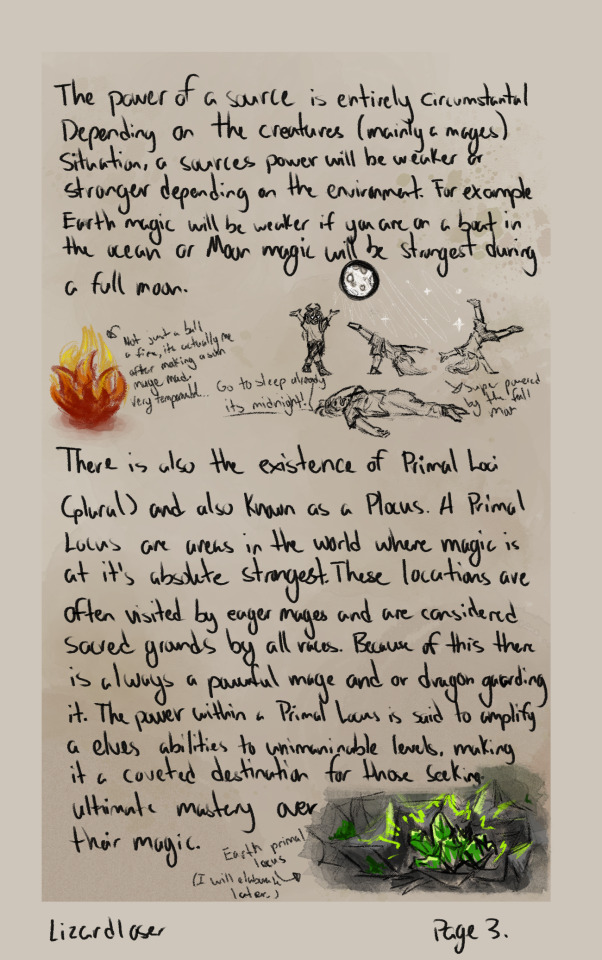
Might wait on page 3 and do some outfit concepts but its already written so idk.
#fantasy worldbuilding#fantasy#writing#art#artists on tumblr#worldbuilding#digital art#character concept#fantasy art#writers on tumblr#Cassie#my art <3#magic#Cassies sketchbook#The Basics on Magic & Classification
5 notes
·
View notes
Text

Diabolik Lovers VANDEAD CARNIVAL (ディアボリック ラバーズ ヴァンデッド カーニバル) Game Guide
Welcome to my very short and to-the-point guide on Diabolik Lovers VANDEAD CARNIVAL! I am making this guide for people who have the most basic understanding of Japanese (aka can understand 白/しろ and 赤/あか... or at least willing to look at the kanji).
Ok so how do you play Vandead Carnival? first off, all the main menus are in English, with more specific settings/submenus being in Japanese. Another note is that this game has love catch - Which means you will get a small animation when you pick the best choice. Make sure to quick save on every choice, so you can pick the best choice.

Once you finish the prologue you will have to pick a family (don't worry you can come back to this screen whenever you want to start a new character). Each family has their own prologue, so you will get the choice to skip it once you've played it once.


Once you've picked you Love Interest (LI) you will start their route. You can play the side missions on the map, but you will want to find your main LI chibi to continue to the next chapter. You will have to win ALL the minigames to get the best ending. Most of the minigames are stupide easy, and if your playing on the Vita the touchscreen will come in handy. Make sure to save before each minigame, just in case (personally the only one I had issues with was Ruki's puzzle). Once you've finished your LI's good ending, you will unlock a Sleeping Vampire bonus. This is basically a short bedtime scenario.


Minigames

Flag Game
This game will give non-Japanese speakers the most amount of trouble. It involves listening and/or reading skills... good news tho, the Japanese used is very easy. Basically the goal is to raise or lower the red or white flag (kind like simon says). The commands will be in Japanese at the bottom of the screen and spoken in Japanese.
My Quick Translations
赤下げて ー Red down
白下げて - White down
赤下げない- Red up (not down)
白下げない- White up (not down)
赤上げて - Red up
白上げて - White up
赤上げない- Red down (not up)
白上げない- White down (not up)
You can get the best ending on easy mode, so don't worry too much.
{下 = down} {上 = up} {白 = white} {赤 = red}

Shell we Dance
This is a very simple rhythm game. Click the corresponding button once the spinning arrow hits it. The timing can be a bit weird with this one.

Hide and Seek
Use the touchscreen and tap the chibis as they pop out. It's ok to miss a few, but try an get as many as you can.

Classification of a Plate
Match the plate to the vampire. It starts with three pates, simply using the touchscreen, drag the drop plates to the corresponding image.



Change of Coffin
This one is like that cup shuffle game... but with chibi vampires lol. This is pretty easy, just make sure you pay attention to the highlighted vampire.

Puzzle
This is the most difficult game imo, its just a shuffle puzzle that appears in Ruki's route. The the timer is a pain but keep shuffling the puzzle pieces and you'll hit the answer eventually.

The Carpet of Magic
use the back triggers to collect stars and avoid bombs. The default position is the middle, so you just have to tap the Vita's let and right triggers.

Pom Pom Cotton Candy
This is another rhythm game, make sure the cotton candy lines up/is on top of the bottom line. The timing for this one is kinda, sorta, horrible...

Balloon Popping
Pop the balloons in the order of the numbers on them. Some numbers will have more then one, you will have to double tap.

Darts
This one is very simple, just line up the sliding bar with the dark read bar 10X. The bar will go a lot faster on hard mode, but you can finish the game just fine on easy.
#otome game#otome#otome game cg#game cg#game#乙女ゲーム#otome game walkthrought#walkthrough#psvita#diabolik lover#Diabolik Lovers VANDEAD CARNIVAL#vandead carnival#diabolik lovers
19 notes
·
View notes
Text
im going to use the owl house as an opportunity to talk about the otherverse again.
we just go through the episode where luz is allowed to study multiple disciplines and i remembered that a friend once asked me how did multidiscipline worked on the otherverse and, after thinking about it, the contrast really is fascinating.
in the otherverse is not, like, strictly enforced that you ought to focus on one discipline. in fact there is a whole class of practitioner called sorcerer, the ones capable of specializing in multiple areas and what's more, magic is so incredibly fluid in the otherverse that its made clear any classification schema is purely an ad hoc thing.
and yet! practitioners do tend to specialize or direct their main focus on one type of magic specifically. oh, its perfectly normal to pick a few tricks from other disciplines here and there. everyone can do a little bit of divination or use glamour or know one or two alchemical tricks. in fact you are kind of expected to know the basics of most disciplines so that you know how to counter them if you ever encounter them in the battlefield.
but the thing is that the way magic works in the otherverse is basically how any career works in the real world. if you want to be really good at something (and the practitioner world is so competitive that you kind of need to be the best to get anywhere) you have to dedicate so much time and effort and resources to it that you barely have any left to dedicate to other things. much like how in the real world is rare for someone to be a proffesional athlete and a neurosurgeon and a pop music celebrity all at the same time.
54 notes
·
View notes
Text
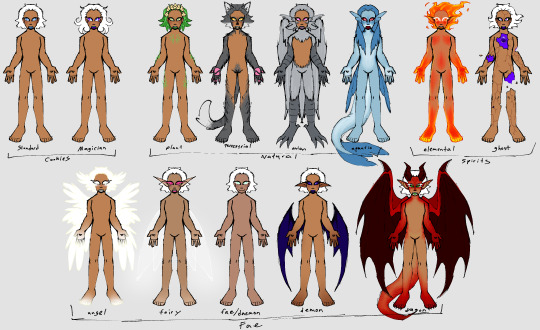
some cookie subspecies classifications with visuals to accompany. if you want to see unfiltered rambling about what these mean copied straight from discord then feel free 2 look below the cut. lotta thoughts on it
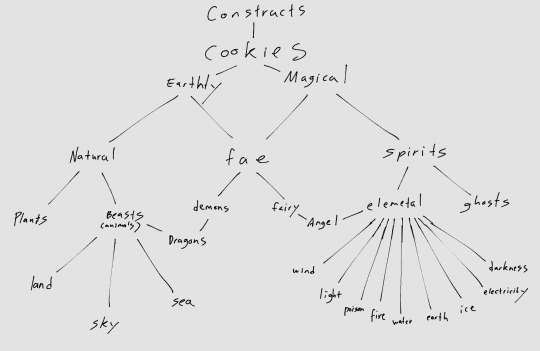
firstly heres the initial chart we drew about this to kind of explain the way things flow down. the elements are the nine elements in kingdom and the beasts are NOT the beast cookies btw.
the BASIS for a lot of this that i'll clarify first; in our lore, cookies are usually made with a traditional gingerbread recipe, with the addition of (at least) two primary ingredients- one Edible component for flavor, and one Magical component for. well. magic. the magical ingredients can often be inedible, but baking them into a cookie can help soften it up (so to speak), as well as hone and amplify its properties.
the ingredients used will determine what a cookie will be classified as on this chart, as well as how heavily a cookie hones their magic during early developmental stages.
[id also like to tag @promniight whos pastry dash au was a big inspiration for me 2 start brainstorming on this kind of stuff. i tried very hard not to make any elements a direct ripoff but the system of "different ingredients bringing out different characteristics" was so good it made me start hyperfixating on this goddamn game again OUHDNKDLLJNDS]
anyways. because i dont have the energy right now to make everything pretty, from here on you will be subjected to my raw 1am discord concept ranting about the different classifications, what they mean, and how to identify them. i'll also put examples of cookies under each blurb!
starting at the basic cookies and ill just rattle off from there. first is the STANDARD build. most basic of basics you can possibly get and the template for all the rest of these. its so bog standard that its entire palette is ripped straight off our gingerbrave design we just made it more sexually ambiguous. this one is essentially what you;d get if you baked a living gingerbread cookie with No extra special ingredients. in its most natural state, its a plain body with a natural dough color, hair and eyelashes matching its frosting (white is the most common and traditional, esp for eyelashes), with its eyes, mouth, and jam all having a monochromatic palette (ex in the example theyre all shades of the same blue).
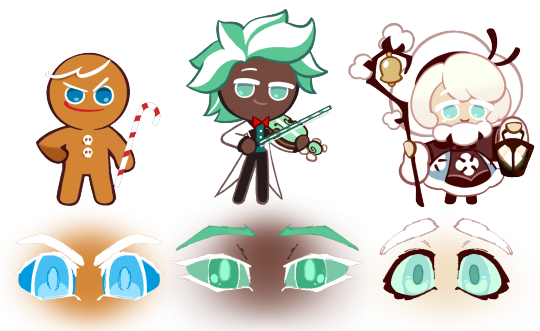
a bog-standard magician is the exact same deal, with a few differences to reflect the further prominence of their magical ingredient. if the first example is an unspecial gingerbread cookie, this is a gingerbread cookie with extra glitter. their eyes, mouth, teeth, and innards can have a secondary color that reflects their magic, rather than the monochromatic palette of the first. these cookie's hair also grows faster because of the higher amount of magic active within them causing their bodies to develop in that way, so unless a magician is very good at maintenance, they'll likely have longer hair and more prominent eyelashes. this is how i have justified my awesome big fantasy eyelash swag
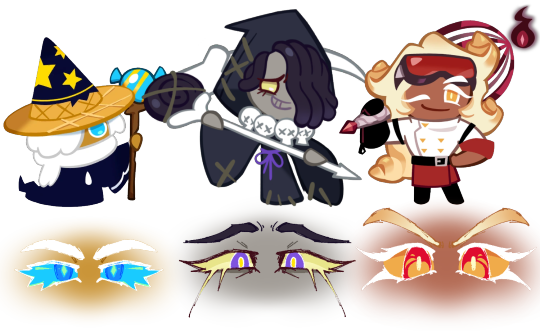
these traits will run pretty standard across the board (ie the natural cookies have monochromatic eyes with shorter lashes while the magical ones tend towards crazier colors with frilly lashes. this isnt actually all that reflected. maybe multicolored eyes are a rare trait for all i know. lets not overthink that yauy)
OKAY SO the natural cookie builds. with how many possible animals there are on gods green earth its impossible to account for every possible variant there could be so i went extremely generic. broadly speaking its a case-by-case basis- i think these four show pretty well the degrees of prominence those Living Thing traits can have across them (this includes plant). at minimum, the ingredient will reflect through their like. hair and patches of their dough, and the "fleshy" bits like the eyes and mouth, as seen on the plant example. from there traits will most often show up at the cookies back and "edges", or where edges laid during the flat period of their life (something about edges being crispy and cooked more, idk), as seen on the terrestrial cat cookie example. then it'll bleed further "in," as seen on the avian, leaving really only the face and torsos dough visible. then with the aquatic cookie, its just all in, dough fully covered in those colorful scales and fins. on each of these i drew them with the most common builds seen throughout our designs but any of them can go in any way- a fish could be as subtle as a few gills on the neck, and a plant could be practically a walking flower. in fact an example of a "fully plant plant cookie" would be our imagining of millennial tree, as his body is built up out of wood, his dough covered in a layer of bark. swag. also avians get an extra appendange instead of their arms being wings because cookies are baked in an inherently humanoid shape and that mold is hard to break without further asension. its easier to tack new limbs on than to completely reshape whats already been hard-baked in. and also the wings look cool like that smiles
ill cover fae next because i grew the spirits last so im following my mental order
a fae/daemon is often classified in the eye of the beholder. theyre that amorphous middle ground between the fairies and demons that cant quite be pinned for what they more closely abide by.. theyre fluid and usually revel in that fact. of course, theyre extremely magical, but with those natural ingredients still prominent. theyre double dipping, those sons of bitches. the most typical form is that it's nigh indistinguishable from a standard member of any other class, only able to be identified by that slight offness to them, and their low-contrast eyes that have no pupils. theyre often shapeshifters of some kind so its usually likely that this cookie form isnt even their real one anymore, especially if theyre magically inclined enough to have ascended.
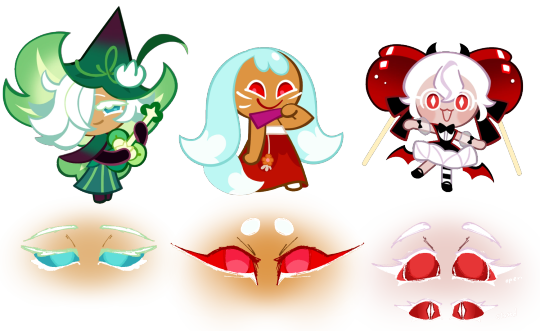
[fae / fae / daemon]
a fairy has a more concrete form than a fae, traits typically including translucent wings of some sort (doesnt necessarily have to be insectoid, its just common), emotive pointy ears, a pale discoloring at their extremities, and eyes that are (similar to fae), low-contrast, but usually more vividly colored and having pupils that match the color of the whites. though other traits arent absurd to see- antlers and flowers (a la plant cookies) and rarer but not too uncommon examples that come to mind, and in the current fae society on beast-yeast (god i need to rename that), ashier dough colors are often seen due to the use of metals like silver, iron, tin, or fucking. mercury apparently. as the magic ingredients in their dough, due to being one of the most readily accessible materials that could offer such properties- materials scavenged from the remains of the witch's banquet hall. (dark enchantress left no magic or ingredients behind... but the silverware probably wasn't worth the effort. tgey were forced to eat forks when they were two years old)
angels are like fairies to the next step. being adjacent to elemental spirits, i think they can come in varied colors and shapes, but can be generally identified by multiple pairs of pale, near-white wings and eyes, with their extremities fading into that color as well (talk about a . magic touch . booyah). theyre can powerful, but tend to be less chaotic than raw elementals or neutral fae. i dont have a lot on angels yet but i think wind archer classifies as an angel.
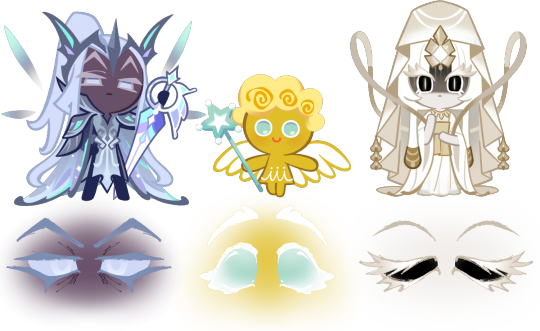
[fairy / angel / angel]
demonsss . guys that tend to embrace the mischeif of the neutral fae/daemons but usually in a more physical manner. like fairies and angels, they tend to have wings, but far more tangible ones- albeit less useful for actually flying. maybe that excess of magic just loves making cookies sprout extra appendages. yk what jot that down. for all i know those could be more arms on all of em. THE MORE IMPORTANT PART IS unlike the fairy wings and even angel wings to an extent, these ones are Solid. Tangible. fairy wings you go right through like mist. angel wings probably work like oobleck. these are tangible Doing Shit appendages. i realize now i forgot to draw the tail but they also tend to get those. long, slender, prehensile is the typical way. they also have long expressive ears and can be pretty quickly identified by their eye trait of white slit pupils on sclera. OH and the darker discoloration on their extremities. you can tell example demon isnt just a Bat avian because of the lack of fur, the white pupils, and the discoloration. okay ? swag
dragons. wgat if demons were really really big and more of a creature. dragons can come in many many many shapes and sizes. especially dragon cookies. the most broad explanation is … a bit chimera with it. traits of an avian, a terrestrial, and an aquatic creature mixes into one greater beast cooked up on the demon cookie frying pan. aside from being broadly recognized by being the "Monster" of the cookie classifications, you can more accurately pinpoint one by, you guessed it, the eyes. wings, tails, scales and horns are common but they cant be your ONLY judgement- after all, you can find those things on any other cookie. cmon now. dragon eyes will, very consistently, be multicolored- a trait that is shared among all fae that i FORGOT TO MENTION UNTIL NOW FUCKK AAAH is that, unlike other cookies, they lack a white outline around their sclera. fucked up ey? for dragons, their eyes are all pitch black, aside from that outline- that's the primary color- and their pupils- thats the secondary. it also makes them look rad as hell. otherwise dragon traits to body ratio follows the same logic that it does for the other Beasts Y Plant cookies- given a lot of dragon cookies are just natural born dragons reincarnating themselves into a cookie form bc theyre all fucking insane i guess, this ratio is usually All Dragon so you wont usually see a shitton of dough.
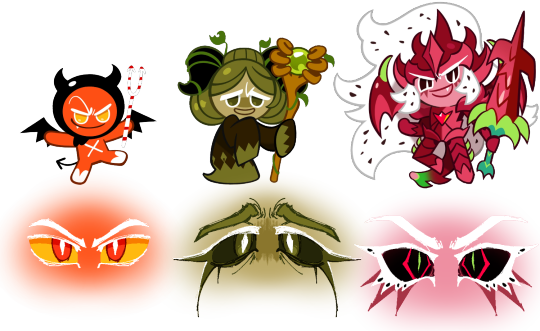
[demon / demon / dragon]
with elementals the biggest thing that defined them is the fact that their body is, either partially or wholly, composed of the element they embody. in a fashion that folllows the Natural cookies stuff, partial elementals will usually have their edges, extremities, and hair composed of that element. a lot are just entirely That Thing though. this can and does make life difficult for some people (ie imagine being a guy made entirely out of Don't Touch substances like Poison or Fire or Electricity. taht would suck. not to mention the intangible ones like Light and Darkness). aside from the obvious Special Guy made out of Slutch stuff, you can pinpoint them pretty quick by their eyes being entirely one color, with only white pupils to break it up. no sclera, no outline. thats why i specified that on dragons and demons. the difference matters. whee
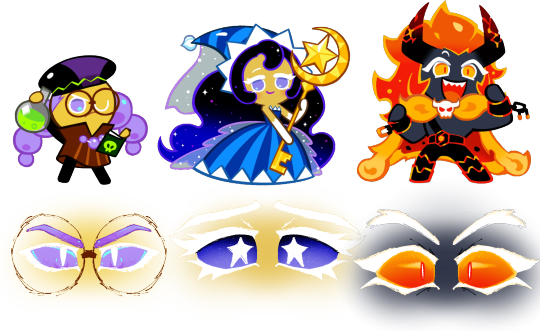
ghosts are the easiest ones because no cookie is born as a ghost, rather Reborn as a ghost. be it through spiritual willpower or rebaking the body anew (looks around), a more accurate term would. honestly be undead. because they arent really a ghost in the traditional sense given the entire point is they still have and inhabit their body. its just. spiritually unstable. rebaked cookies will naturally be much more stable ghosts than those who just put their own crumbs back together, but all of them, having their souls at least partially seperated from their bodies, can fade in and out of a less tangible form. you can fade through anything if you make your crumbs fine enough. self-revived ghosts are usually the easiest to identify, with large, deep, and visible cracks across their bodies, as well as areas just straight up missing pieces. rebaked ghosts will also have those cracks, but moreso as scars- spots that were missing would be filled in with discolored dough (hard to make the exact recipie twice down to the exact color). all ghosts will have tapered off fingers and toes (funny claw justification. i can imagine it simply being a matter of the dough wearing away over time, faster at the finer points. like a candy cane). they'll also very rarely bleed- most of that jam is either coating their dough to hold together, or condensed in their soulstone so as to protect what's left of it. something like withdrawing itself. their hair and stray crumbs will be naturally floaty (strong emotions can extend that effect to their immediate environment). and the eyes, always the main giveaway- hollow, showing the dark inside of the head, with purely white sclera and pupils being their primary color. a bit haunting innit
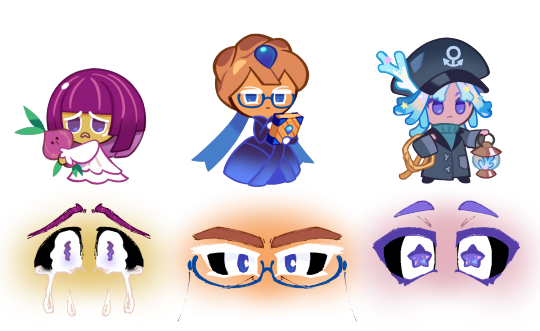
uhh ok tldr guide for the road
standard cookies are just some guy. humanoid. monochromatic eye colors. white outline around sclera. cookies follow this guide unless specified otherwise.
magicians are just some guy but with magic. you can tell theyre magic because they get Two Unique Colors in their eyes and their hair grows faster.
natural cookies show their naturalness as the edges. we love extra appendages here. plants grow leaves and animals grow fur/feathers/scales/whatever else. yay
neutral fae/daemons are the silly putty of the equation but usually they look like just some guy but Watch Out. can be easily identified by pale eye color and a complete lack of pupils.
fairies get funny translucent wings and big elf ears. they dont have white sclera outlines, scelera barely sticks out from whites, and whites are the same color as pupils. their extremities are a Little pale
angels favorite color is white and anything near it. theyre practically glowing. multiple wings/extra limbs/whatever. eyes are like entirely blank i think i forgot to say that. extremities are the same near-white-if-not-white color as the wings and eyes.
demons have white slit pupils and pointy ears too. their extremities are Darker. their wings/extra limbs/whatever are fully tangible but arent super functional but its ok bc they look cool. and they have prehensile tails to compensate. also their sclera outlines are black instead of white
dragons follow the same principals as the natural squad and posses traits of at least one of each (terrestrial avian and aquatic beast). their eyes are black except for the places where they arent. pupils are one color and sclera outlines are another and thats it. the rest is black
elementals are when a guy is made of an element. their eyes are one color everywhere aside from white pupils. ez ghosts are crumbled cookies. you can always tell theyve been crumbled bc cracks. they have creepypasta eyes (hollow w white sclera and colored pupils) and dont bleed. theyre floaty!
[discord rant over] if you read this far thank you and i hope this is even remotely comprehensible. a lot of cookie stuff is still in workshopping and even this will def get more fleshed out as we brainstorm for it.
if you made it all the way down here, send in a kingdom cookie (not a beast or ancient) and i'll try and sketch a design for them in our rewrite! this is not me promising anything, i just want to do more designs and. this seems like a fun way to do it perhaps. in general, feel free to shoot any questions about the rewrite our way too!
also: a rough chart of where the kingdom cookies could fall in terms of classification. this isnt really final or super concise

22 notes
·
View notes
Text
D&D 5e Odd Spell School Classifications
Browsing spells in 5e, and there are some very odd justifications for some spells being the school they are, you know?
Easy example: Speak with Animals is divination, Speak with Dead is necromancy, and Speak with Plants is transmutation. Surely all of those are knowledge-seeking spells, and should be classed under divination? If divination spells can talk with gods, they’re fine to talk with spirits, there was no need to bring necromancy into this. And the justification for Speak with Plants is that you have to transform the plant into something sentient enough to communicate with, but in that case … how was it sentient enough to have useful information before you did that?
Similarly, every other Summon spell is conjuration. Except Summon Undead, which is necromancy.
Like, there’s a thing here where some schools are defined by how they do things (transportation magic is conjuration magic), while other schools are defined by what they do (literally anything to do with death comes under necromancy, no matter what the methods involved). Necromancy is so bad for this. Why is Spare the Dying necromancy instead of abjuration? It’s on a living person. It’s to ward off death! Surely that’s abjuration?
Transmutation is also an odd duck. The line between evocation and transmutation seems to be that if you’re creating an element from thin air, that’s evocation, while if you’re controlled pre-existing material, that’s transmutation. But transmutation also covers more esoteric things, like gravity, or just physics? I’m thinking Catapult, here, and Reverse Gravity. It also has some odd border cases with conjuration, too. Blink, for example, really feels like it should be conjuration, and Etherealness, because in both cases you’re hopping into the ethereal plane, and transportation magic is supposed to be conjuration. And why is Thorn Whip transmutation when literally every other ‘summon plant’ spell (Entangle, Wall of Thorns) is conjuration? Is it just because the Thorn Whip moves?
Then we have both Pass Without Trace (abjuration) and Shadow of Moil (necromancy), both of which summon shadows to protect the caster, which is odd because using shadowstuff is usually the domain of illusion. Pass Without Trace fully should be an illusion spell. And if we’re justifying it that it’s used to protect, why is Shadow of Moil, which does the same thing in basically a more concentrated fashion, suddenly necromancy?
It definitely does feel like they were trying to pad certain schools out (necromancy), but there’s just a lot of general confusion over why certain spells should go certain places.
In some ways this is cool, and I can see gleeful in-universe wizards having arguments over what should go where. But I would also like to fully dissect all the schools and stake out their rules, you know?
21 notes
·
View notes